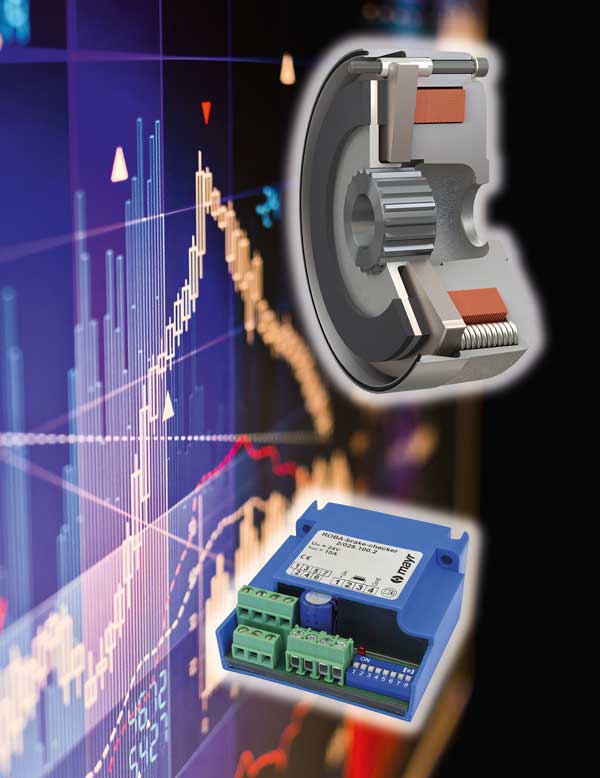yesterday | Drive technology archive
- Details
- Hits: 1836
Do you like to remember yesterday? Then we have the development of the drive technology here 2011 – 2019 put together for you. Hiperface DSL, compactness, networking capability and much more was the focus of the developments. Have fun and exciting déjà vus with the drive memory!

Contents
Brakes
The current brake innovations can be found here here.
Archive for safety brakes
You can find the latest safety brake innovations here.
- Clutch and brake monitoring for automation and robotics
- Predictive maintenance with intelligent control for 4.0 brakes
- Safety brakes for the challenges of the industry 4.0
- Our entry into Industry 4.0 - Interview
- Electronic brake torque control for spring applied brakes
- Spring-loaded safety brake instead of permanent magnet brake
- With Roba Top-Stop for a secure hold - statement
- What makes a brake to the safety brake?
Predictive maintenance with intelligent control for 4.0 brakes

07.10.2018 | Mayr Antriebstechnik presents new versions of the intelligent modules "Roba-brake-checker" and "Roba-torqcontrol". You can easily and quickly monitor safety brakes or enable them smooth and smooth deceleration of machines – even with variable loads. The two Roba modules make brakes fit for the challenges of Industry 4.0 and also create the conditions for preventive error detection and maintenance.
The Roba-brake-checker is now also available in one Version for AC voltage. In a further expansion stage, the module also controls the brake and thus replaces a rectifier. Switching state monitoring and brake control are thus combined in one device.
With the Roba-torqcontrol module, the company has developed an intelligent and economically attractive solution with which customizable braking responses are possible and machines can be brought to a defined standstill - regardless of the respective load status. Until now, the spring-loaded safety brakes, which due to their design only recognize the two operating states "braking torque available" and "braking torque cancelled", have been dimensioned in relation to the maximum load. This is particularly problematic with devices and machines that can have changing loads if they are only partially loaded. So if the load is significantly lighter than the maximum permissible, the braking torque may be far too high. The sudden braking can then damage the load and pose a danger to people and machinery.
Braking torque changed during operation
The solution to this lies in the steering: The intelligent control module Roba-torqcontrol changes the braking torque during operation. For this purpose, current and voltage are specifically influenced. The module thus offers the possibility of setting up control loops and movements intelligently zu slow down – ideal basis for use in the smart, networked machine. In this way, the brake can be adapted to the current load at any time.
 Compensating couplings for high temperatures
Compensating couplings for high temperatures
Roba-torqcontrol can integrate the brake into a control loop controlled according to different parameters. Consistent braking torques, stopping distances or delay times can thus be achieved. All that is required is a signal transmitter, which supplies a PLC with the necessary information, for example. This in turn converts these signals into instructions for the Roba-torqcontrol module. Older machines can be retrofitted much more easily with the intelligent system.
Permanent brake monitoring
To control electromagnetic safety brakes, the drive specialist has developed an intelligent solution for monitoring the brakes with the Roba-brake-checker module. Both modules are based on the same functional principle. The Roba-brake-checker module is used exclusively for monitoring the brakes, the Roba-torqcontrol module also has the monitoring function and can also control the brakes. Depending on the application, users can choose the appropriate solution. The two modules work without a sensor on the brake in a protected environment from the control cabinet.
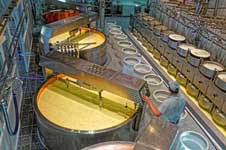 Clutches and brakes Use in food technology
Clutches and brakes Use in food technology
In addition to the switching status, you can also deduce Temperature, wear and tear or traction reserve, ie whether the magnet is still able to attract the armature disk. With the new modules, significantly more processes are mapped during monitoring than was previously the case, for example, with Hall sensors or microswitches or inductive proximity switches. When the traction reserve is reached, the Roba-brake-checker and Roba-torqcontrol send a warning signal so early that the brake can still be operated for a certain period of time. During this time, the machine operator can perform maintenance in a targeted manner that is tailored to his work process.
Safety brakes for the challenges of the industry 4.0
17.02.2017/XNUMX/XNUMX | Monitoring modules of the latest generation, a technologically leading friction system and consistently considered safety principles - that's what the Brake Technology 4.0 from Mayr drive technology. The perfectly coordinated overall system stands for maximum operational and functional safety and also increases the productivity of machines and systems through preventive error detection and maintenance. The drive specialist thus offers reliable safety brakes that are equipped for the challenges of the fourth industrial revolution.
Brake Technology 4.0 stands for the latest generation of monitoring modules: modules like Roba-brake-checker or Roba-torqcontrol enable permanent brake monitoring. In this way, Roba-brake-checker monitors not only the switching status but also the tension or tension reserve and detects safety-critical changes in voltage, air gap and temperature. This means that significantly more processes than before are mapped when monitoring the safety brakes.
When the traction reserve is reached, the module is sent in early Warning signthat a certain operating time of the brake is still possible. During this time, the machine operator can carry out maintenance tailored to his process. The module also controls the brake at the same time, replacing a rectifier. Switching state monitoring and brake control are thus combined in one device.
For applications that, in addition to condition monitoring, also require a braking torque control require, the braking torque control module Roba-torqcontrol is suitable. It shares the properties of the Roba-brake-checker and can also change the magnitude of the braking torque during operation by specifically influencing current and voltage. Devices and machines can be decelerated evenly and gently. With this module, control circuits can be set up and movements can be intelligently braked - the ideal basis for use in the smart, networked machine.
Friction lining technology with improved torque consistency
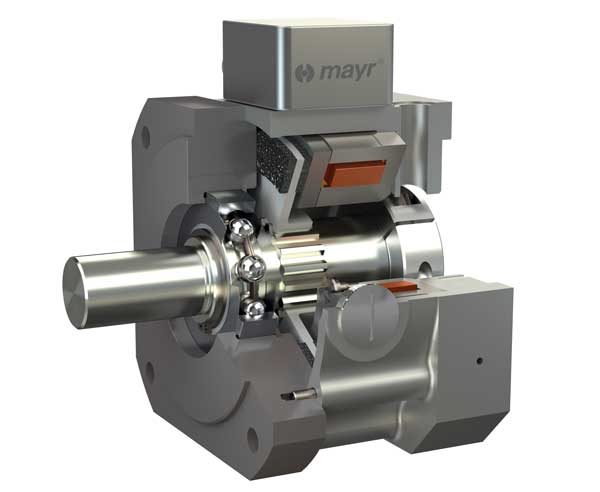 The company's developers have succeeded in creating a new friction lining technology with which the brakes achieve further improved torque consistency and higher power density. With the new ones multi-layer coverings higher braking torques and higher surface-specific friction work can be achieved.
The company's developers have succeeded in creating a new friction lining technology with which the brakes achieve further improved torque consistency and higher power density. With the new ones multi-layer coverings higher braking torques and higher surface-specific friction work can be achieved.
That means: build the brakes more compact with the same properties. For higher braking torques and higher stressed brakes, a smaller, lighter brake size can be selected under certain circumstances. This takes into account the general trend that machines and their components such as motors are becoming increasingly compact and powerful today.
The Brake Technology 4.0 is therefore a comprehensive overall concept behind which, on the one hand, there is a technologically leading friction system which, together with consistently considered safety principles, stands for reliable, safe and extremely powerful brakes. Monitoring solutions are firmly connected to this. And so brakes and the associated monitoring modules master all challenges where today safety regulations and standards meet Industry 4.0. They meet the requirement of mapping all processes involved.
Our entry into Industry 4.0
23.11.2016/XNUMX/XNUMX | Mayr Antriebstechnik will be exhibiting at the SPS IPC Drives in Nuremberg presented the new brake monitoring system and an overload clutch that automatically engages again. Günther Klingler, Managing Director, Chr. Mayr GmbH + Co. KG, Mauerstetten gives us a short introduction.
Electronic brake torque control for spring applied brakes

27.02.2015/XNUMX/XNUMX | Nobody would think of it Automobile to operate the handbrake at full speed. The driver uses the foot brake to slow down the car in a targeted manner. Even with dynamic braking in mechanical engineering, there is often a metered, even delay desirable. With the new intelligent braking torque control module from Mayr Antriebstechnik, devices and machines can be decelerated evenly and gently. The module is suitable for use in smart, networked machines.
Because spring-applied brakes different from car brakes Due to the design, if you only know the two operating states "braking torque-available" and "braking torque-canceled", each braking process takes place with the maximum available braking torque. With the intelligent braking torque control module, the drive specialist offers an economically attractive solution to generate a variable torque with Roba-stop spring-applied brakes and thus to decelerate components evenly and gently.
Infinitely adjust the contact pressure on the brake pads
For devices with alternating loads such as Industrial trucks So far, the brake has been dimensioned based on the maximum load. However, it does not always make sense to work with the full braking torque. In the case of a partial load, greater deceleration can damage the goods being transported or even cause the wheels to slip.
If the system detects the operating status and converts this into a default signal for the switching device, electronic braking torque control is possible. With the system, the Contact pressure on the brake pads and thus the braking torque during operation change continuously. In addition, in applications that require a constant braking torque within narrow tolerance limits, the braking torque control can be used to compensate for negative influences on the braking torque constancy.
The intelligent switching device is operated with 24 or 48 V DC voltage and can control brakes with a rated coil current of 10 A or 5 A. The resulting clamping force for the brake rotor can be set to 25, 50 or 75% of the nominal spring force via two digital inputs. Alternatively, an infinitely variable analog default signal from 0 to 10 V is also possible.
Sensorless determines that Switching devicewhether the armature disk has attracted or fallen off. This means that the overexcitation time can optionally be adjusted automatically. Because the intelligent switching device detects the switching status of the holding brake, no microswitches or proximity switches are required. The device also determines possible wear reserves and, if necessary, detects impermissible heating.
Spring-loaded safety brake instead of permanent magnet brake
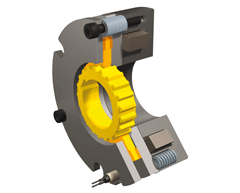
31.07.2013/XNUMX/XNUMX | Mayr Antriebstechnik presents for use in servomotors an alternative to permanent magnet brakes (PMB): The new spring-loaded safety brake Roba-power stop works according to the so-called "fail-safe" principle and thus offers the greatest possible safety even in the event of a power failure or emergency stop. For example, it is predestined for use in gravity-loaded axes of machine tools, handling portals or assembly equipment.
Usually will servomotors equipped with PMB. They are relatively inexpensive and power dense. In the meantime, however, the cost advantage is disappearing because the Magnetic materials very expensive became. Therefore, the drive specialist now sees good opportunities for the spring-loaded brake. It is less sensitive than the PMB, because with the very high temperatures of 120 °C and more that are often reached in the motor today, the permanent magnets can lose their magnetic force, which leads to a drop in braking torque.
The spring applied safety brake is PMB also superior in terms of construction: When braking while moving, mixed friction occurs due to the pairing of iron-iron and iron-friction lining. Strong fluctuations in the coefficient of friction and low permissible friction work and friction power are typical for this friction pairing. This is not a problem with static braking because the holding brake is applied when the drive is stationary. However, the situation is different with dynamic emergency braking from full speed: Here, fluctuations in the coefficient of friction have a direct effect on the magnitude of the braking torque. In addition, PMB are not designed for high friction work and damage to the total failure of the brake is possible.
When the spring-loaded safety brake is closed, the rotor with the friction linings held between the armature disk and the brake plate. If the built-in magnetic coil is energized, the magnetic field pulls the armature disk against the force of the springs onto the coil carrier and thus releases the brake. Thanks to this fail-safe principle, the servo brake works safely and reliably.
In addition, the Roba-servostop is suitable for use under Ambient temperatures up to 120 °C. The high temperature resistance is possible because the braking torque is generated by special organic friction linings. These temperature-resistant pads have a high, even coefficient of friction.
The ROBA-servostop permits a Tenfold increase in load mass ratios: In the case of servo drives, load mass ratios of the load to motor of the order of 3:1 or less are normally selected in favor of good control properties and high dynamics. The ROBA-servostop allows load mass ratios of 30:1 and more due to its high permissible friction work and friction power. While permanent magnet brakes tend to "seize" under such conditions and thus possibly cause a sharp increase in braking torque, possible damage to the drive train is avoided with the ROBA-servostop.
Low wear and easy installation
When developing the components that generate braking torque and all other components involved in transmission, the engineers paid attention to high performance and low wear. In addition, the simple and robust construction of the Roba-servostop makes assembly much easier. Of the operating air gap does not need to be adjusted and precise axial positioning on the motor shaft is unnecessary. The brake always works precisely and reliably with a constant air gap and is not affected by bearing play and temperature expansion. The installation effort is also significantly lower than with permanent magnet brakes. Assembly errors are almost impossible.
If servo brakes are installed in the A end shield of the motor, thermal expansion does not have a serious impact because this is where the fixed bearing is located. If the brake is on the B-end shield of the motor, the position of the part of the brake on the shaft relative to the part of the brake that is attached to the end shield changes when the temperature changes. With a PMB, for example, this can impermissibly change the working air gap in the brake. The Roba-servostop can be used without restriction also in the B bearing side of the motor, since thermal expansion and bearing play do not have a negative impact on the function and reliability of the brake.
With Roba Top-Stop for a secure hold
22.11.2011 | Günther Klingler, Managing Director Chr. Mayr GmbH + Co. KG, Mauerstetten, presents the highlight at the SPS/IPC/Drives in Nuremberg, the modular safety brake Roba-topstop.
The Roba-topstop is a safety brake especially for vertical and inclined axes. It increases the safety of vertical axes and is a suitable safety component for the Standard EN ISO 13849-1 to meet.
What makes a brake to the safety brake?
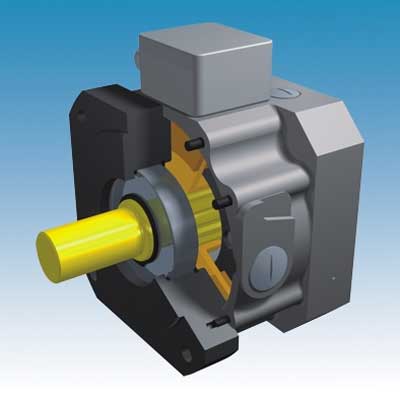
02.10.2010 | Mayr power transmission takes into account in the development and production of Roba stop Braking consistently basic and proven safety principles, long before they are in the standard ISO 13849-2 have been defined. All components are safely dimensioned and made exclusively from high-quality, well-known and proven Materials made.
The EN ISO 13849-1 standard stipulates that safety concepts must be implemented in machines. This obliges plant and machine manufacturers to check their products for compliance with the new standard and, if necessary, to adapt them to the Avoid endangering people. Dangers arise, for example, if vertical axes drop unintentionally.
There are basically several ways to achieve the required Performance level with such axes to reach. An extremely effective variant is an additional, redundant safety brake. But not every brake is suitable for this. It must have the following characteristics in order to meet the requirements of the new standard:
The basic requirement is that it works according to the fail-safe principle, i.e. that it is closed when it is de-energized. But that alone says little about the quality and reliability of a brake. With the Roba-stop brakes, for example, are the ones used Helical compression springs to generate the braking force from stainless steel and to a durability of 10 million load changes tested.
Spring know-how pays off
The use of proven springs made from known materials pays off. In 40 years of field experience these have proven that they will not break. Additional security results from the application of the tried and tested security principle "multiplication of parts". Usually more than 5 springs work in one brake. This reduces the effect of errors.
Mayr has also been practicing for a long time proven construction principles, which have now been defined in the standard, and uses adequately guided springs in its brakes with a wire diameter larger than the distance between two coils. However, should a spring break, the two fragments cannot screw into each other. The original spring length and the spring force are largely retained. What applies to the springs, of course, also applies to all other components, namely the consistent consideration of tried and tested safety principles.
The safe function of the brake also requires a safe control. Jamming contactors, welded contacts or other errors must not impair safety. Safe controls can be set up with redundant control elements connected in series in connection with error detection and fault reports. This ensures that the brake is always safely disconnected from the power supply, for example in the event of an emergency stop, and that it brakes reliably.
Couplings
You can find the latest coupling innovations here.
Claw Couplings Archive
You can find the latest claw coupling innovations here.
- Torsionally flexible coupling with new toothed rim mixture
- Elastomeric coupling with keyway and spline connection
Torsionally flexible coupling with new toothed rim mixture
 May 24.05.2011, XNUMX | Electric drives are becoming increasingly more powerful, more compact and more dynamic. This also has an impact on the torsionally flexible couplings, which are tried and tested Sprocket mixtures always reaching their limits. As a result, users often resort to sprockets made of Peek or other expensive special compounds in harsh environmental conditions.
May 24.05.2011, XNUMX | Electric drives are becoming increasingly more powerful, more compact and more dynamic. This also has an impact on the torsionally flexible couplings, which are tried and tested Sprocket mixtures always reaching their limits. As a result, users often resort to sprockets made of Peek or other expensive special compounds in harsh environmental conditions.
KTR coupling technology has therefore been looking for a new material with a wider range of uses for the "Rotex" claw couplings and, after comprehensive test series carried out together with leading plastic manufacturers, found this with the all-round material "T-Pur".
This sprocket mixture is the most commonly used claw coupling worldwide significantly more flexible in use. The new material is characterized, among other things, by a larger temperature window: While conventional gear rim materials can be used at temperatures from -30° to +90°C, T-Pur is suitable for -50° to +120°C.
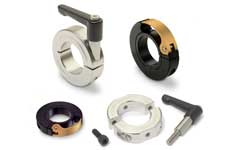 Adjusting ring and clamping ring innovations for shafts and axles
Adjusting ring and clamping ring innovations for shafts and axles
The fatigue strength is also significantly better, so that the service life of the coupling system is increased and the maintenance intervals can be extended. Even with higher dynamic requirements such as variable speeds and frequent reversing operation
T-Pur as the better material.
The new material is used for the standard sprockets Rotec-Claw Clutches from size 14 to size 90 used. Depending on the desired damping behavior, different degrees of hardness or elasticity are available from 92 Sh-A to 64 Sh-D. From size 100, KTR supplies double tooth elements, which are also made from the new material.
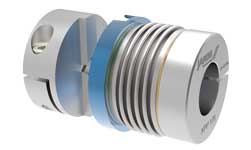 metal bellows coupling | Innovations, applications and special features
metal bellows coupling | Innovations, applications and special features
The gear rim material was tested under real operating conditions in many common areas of application and wherever the standard elastomers previously used could not guarantee the required fatigue strength or temperature resistance. In practice, the desired service life was achieved with the new elastomer. Field tests with customers also confirmed the superiority of the T-Pur sprockets.
Elastomeric coupling with keyway and spline connection
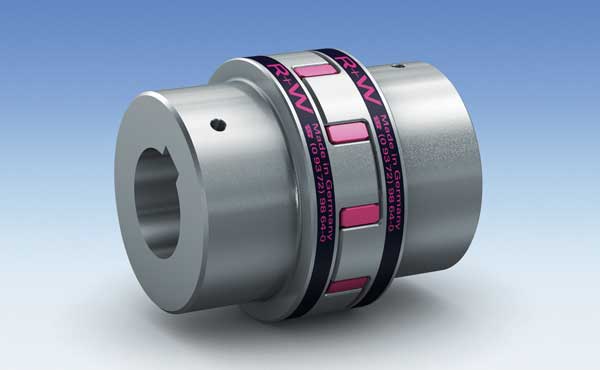 14.12.2010/1/XNUMX | The company's EKXNUMX elastomer coupling R + W is now available in the 2500, 4500 and 9500 series for torques up to 25.000 Nm. For the new series, the elastomer ring has been segmented, which makes assembly of the coupling and maintenance easier. The segments are available in two versions, Shore hardness 98 Sh A, or 64 Sh D, depending on whether better damping properties or a higher torque to be transmitted are required.
14.12.2010/1/XNUMX | The company's EKXNUMX elastomer coupling R + W is now available in the 2500, 4500 and 9500 series for torques up to 25.000 Nm. For the new series, the elastomer ring has been segmented, which makes assembly of the coupling and maintenance easier. The segments are available in two versions, Shore hardness 98 Sh A, or 64 Sh D, depending on whether better damping properties or a higher torque to be transmitted are required.
Another innovation is that the connection to shafts with a diameter of 30 to 170 mm is now also possible via the standard feather key Multi-wedge is possible. This increases the load-bearing portion of the connection and equally relieves the load on the material of the shaft and the hub. Security increases. The new EK1 series provide an economical alternative for applications in which the properties of an elastomer coupling are required at very high torques.
Shaft Couplings Archive
You can find the latest shaft coupling innovations here.
- Multi-plate clutch for maritime use
- Torsionally rigid shaft coupling for measuring flange in the test bench
- Shaft coupling with integrated torque measurement
- Multi-plate clutch for torques up to 110.000 Nm
Multi-plate clutch for maritime use
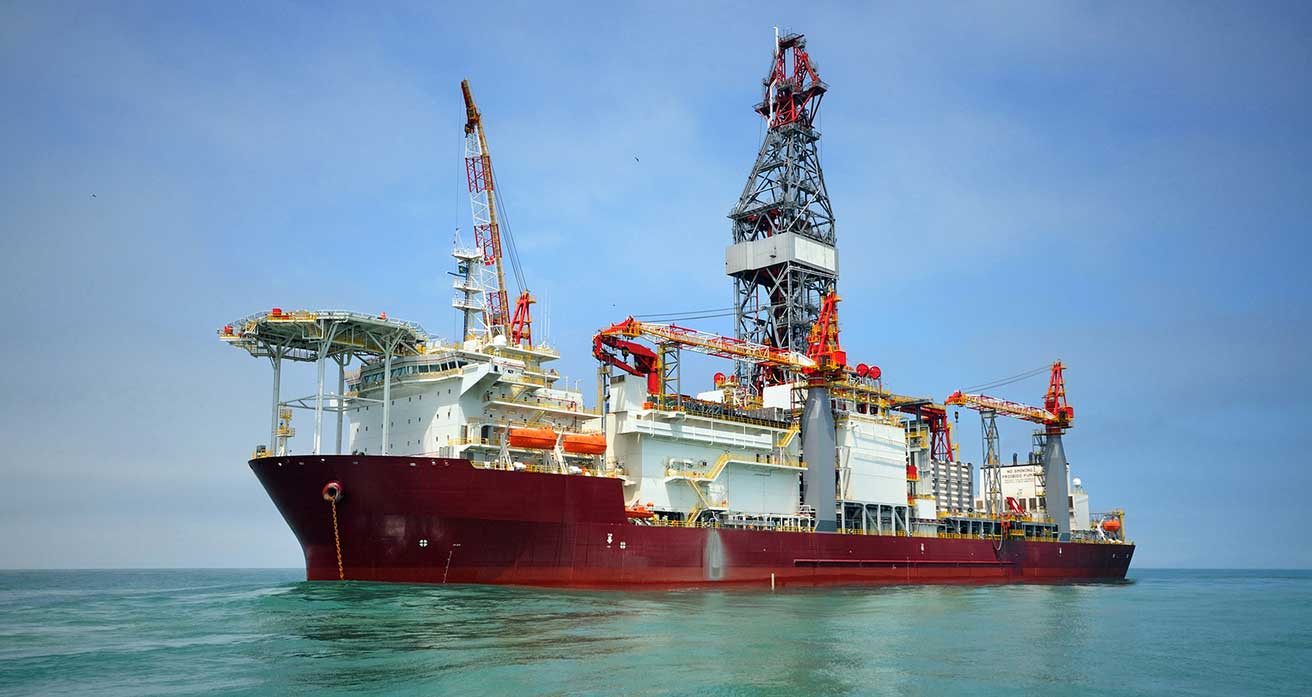
05.02.2016 | Whether in drives for ship propellers, mobile platforms such as drilling platforms for oil and gas production or in tidal power plants - the areas of application of disk pack couplings in the maritime industry are diverse. The compact and high-performance "Roba-DS" multi-plate clutches from Mayr are DNV GL certified for these applications. They offer users on the high seas the greatest possible operational and functional safety.
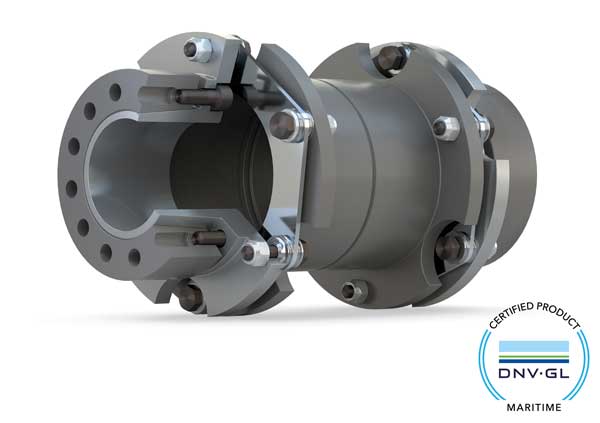 For example, if the main drive of a ship's propeller is a Electric motor, so offers the Spring steel multi-plate clutch like the Roba-DS decisive advantages: These couplings are robust, reliable and temperature-resistant. They are therefore particularly suitable for use under the extreme environmental conditions at sea. In addition, they work wear-free and thus reduce the necessary maintenance effort to a minimum. As with the previous Roba-D model, the drive specialist has also received type approval from DNV GL (Det Norske Veritas and Germanischer Lloyd) for the more compact and more powerful Roba-DS all-steel couplings up to size 2200.
For example, if the main drive of a ship's propeller is a Electric motor, so offers the Spring steel multi-plate clutch like the Roba-DS decisive advantages: These couplings are robust, reliable and temperature-resistant. They are therefore particularly suitable for use under the extreme environmental conditions at sea. In addition, they work wear-free and thus reduce the necessary maintenance effort to a minimum. As with the previous Roba-D model, the drive specialist has also received type approval from DNV GL (Det Norske Veritas and Germanischer Lloyd) for the more compact and more powerful Roba-DS all-steel couplings up to size 2200.
The nominal torques specified in the catalog can be used without restriction. A reduction of the nominal torque due to displacement, collective load or balancing requirement is not necessary. The couplings are compact, power-dense and very small - ideal for marine engines, in which only little installation space is available. With providers who have to take displacements and alternating torques into account when dimensioning, a larger coupling often has to be selected for the same nominal torque and the same speed.
These multi-plate clutches transmit torques up to the nominal torque absolutely free of play and with consistently high torsional rigidity. The specified shaft misalignments can be used 100% in total without affecting the transmittable torque. The multi-plate clutches compensate for radial, axial and angular misalignment of shafts and thus protect the bearings from unwanted loads and thus from unnecessary downtimes and costs.
Torsionally rigid shaft coupling for measuring flange in the test bench
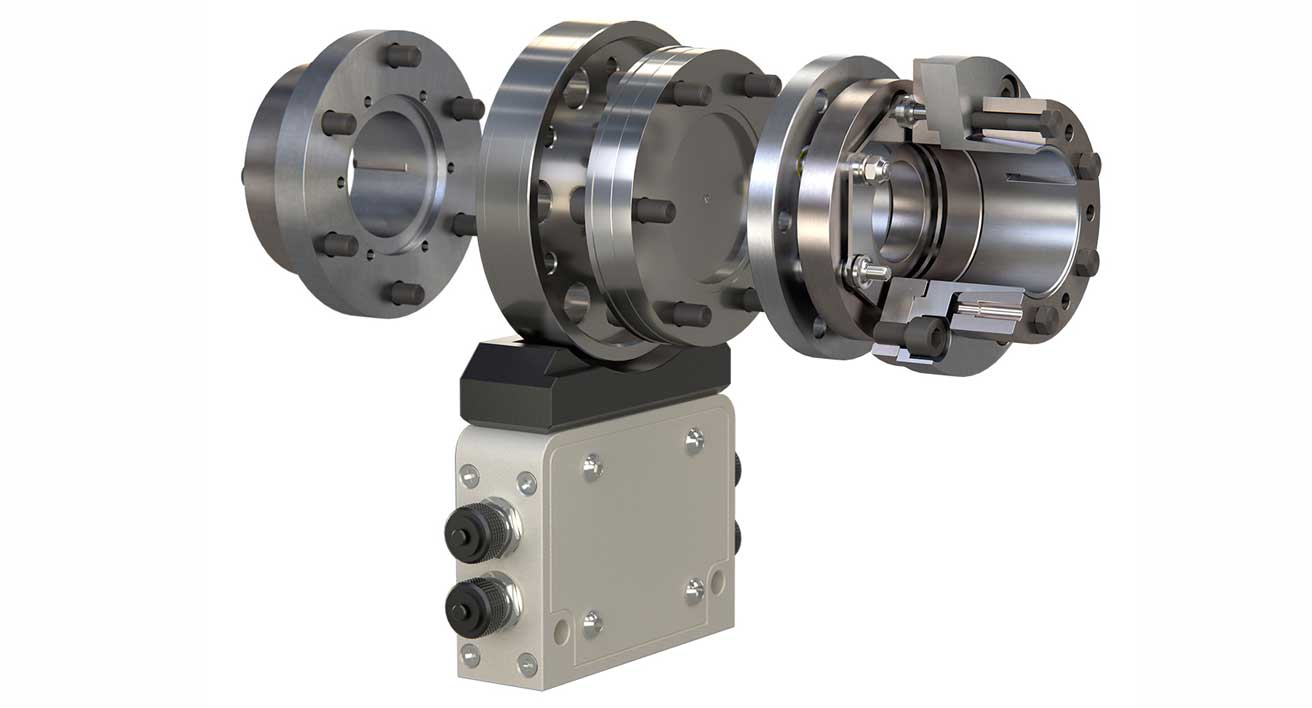
17.02.2016/XNUMX/XNUMX | An indispensable component for torque measuring flanges in test benches is the shaft coupling, which reliably compensates for any shaft misalignments. Because that's what she takes care of torsionally rigid coupling for precise measurement results and also protects the bearings installed in the shaft train from wear. Based on the backlash-free Roba-DS disk pack coupling with high torsional rigidity, Mayr offers a compensating coupling for the high requirements of the measuring flanges.
Short development times, an improved one Efficiency or more potential for energy savings - the demands on test stands are growing steadily. This also increases the performance requirements for the torque measuring flanges as the heart of modern test benches, which have to deliver accurate and reliable data even in high-performance and high-speed applications.
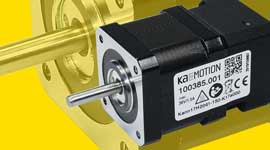 Stepper motor program with encoder + controller
Stepper motor program with encoder + controller
However, the measurement result of these applications is only as good as the one used shaft balancing clutch. Because shaft couplings are a crucial component in order to minimize the disturbance variables affecting the measuring flange. Such disturbances are often caused by alignment errors in the drive train. In almost all applications, radial, angular and axial shaft misalignments occur between the input and output side. Even aligning the shaft assembly as precisely as possible with state-of-the-art laser alignment devices can only help to a limited extent.
In addition, the offsets can be replaced by existing ones Tolerances in dimensional accuracy of the components used and external influences such as temperature cannot be completely eliminated. For this reason, torsionally stiff shaft compensation couplings are used together with the measuring flange. The Roba-DS were specially tailored to the requirements of modern measuring flanges.
Shaft couplings compensate for shaft misalignment without backlash
 This backlash-free disk pack coupling is equal to radial, axial and angular Shaft misalignment out. It not only ensures precise measurement results, but also protects the bearings installed in the shaft train from undesired loads and thus from unnecessary downtime. With the Roba-DS shaft couplings, the nominal torques specified in the catalog can be used without any restriction.
This backlash-free disk pack coupling is equal to radial, axial and angular Shaft misalignment out. It not only ensures precise measurement results, but also protects the bearings installed in the shaft train from undesired loads and thus from unnecessary downtime. With the Roba-DS shaft couplings, the nominal torques specified in the catalog can be used without any restriction.
A reduction in the Nominal torque due to displacement, load spectrum or balancing requirement is not necessary. The couplings are compact and at the same time combine high power density with absolute freedom from backlash. They transmit torques up to the nominal torque absolutely backlash-free and with constantly high torsional rigidity. The specified shaft offsets can be used up to 100% without affecting the transmittable torque.
Torsionally rigid coupling tailored to the test bench
The shaft coupling is particularly robust and insensitive and, in addition to its smooth running and the low inertia a high balance quality. The torsionally rigid coupling covers the standard designs of the Roba-DS coupling, depending on the size, with speeds of 8000 to 18.000 rpm-1 .
The shaft coupling must have a balance quality of G 2,5 (reference speed 3000 min-1) balanced. In the High-speed design, in which the individual parts are manufactured with very high accuracy (quality IT5) and narrow radial and axial run-out tolerances, speeds of up to 30.000 rpm are possible-1 allowed. The balancing quality of the clutch is G 2,5 at a reference speed of 5000 min-1.
The coupling and measuring flange are usually connected to the shafting without play using a high-quality Clamping ring hub. Various coupling designs specially tailored to the different requirements of the test benches and flexible combination options also enable the integration of measuring flanges in almost any test bench and drive constellation.
How the Roba-DS shaft coupling works
The backlash-free multi-disc clutches compensates for axial, radial and angular shaft misalignment. Watch the video to see how the shaft coupling works.
Shaft coupling with integrated torque measurement
 01.07.2014/XNUMX/XNUMX | The torque-measuring shaft coupling Roba DSM from Mayr drive technology is based on the proven backlash-free Roba-DS shaft coupling. The field of application of this torque measurement coupling ranges from test bench construction to use in series machines to Condition monitoring. The system enables simple condition monitoring of machines and systems. Machines can be optimally utilized with the data from the clutch.
01.07.2014/XNUMX/XNUMX | The torque-measuring shaft coupling Roba DSM from Mayr drive technology is based on the proven backlash-free Roba-DS shaft coupling. The field of application of this torque measurement coupling ranges from test bench construction to use in series machines to Condition monitoring. The system enables simple condition monitoring of machines and systems. Machines can be optimally utilized with the data from the clutch.
Measurements on rotating parts require the transfer of energy to the rotating part and the transfer of data from the rotating part. In the past, power and data were mainly transmitted inductively. This principle has some disadvantages compared to the wireless data transmission of the new Roba-DSM such as small distance, more complex assembly, lower tolerances for vibrations and concentricity.
Stored systems also require one torque arm. The Roba-DSM does not require an enclosure and therefore only little installation space. The stator can easily be mounted anywhere on the circumference. When setting the stator, large tolerances are permissible in all directions. The possible distances of up to 5 mm are significantly larger than in comprehensive systems.
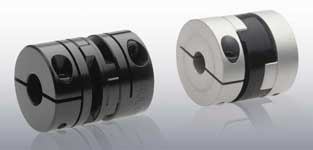 Compensating Couplings | Innovations Overview of various manufacturers
Compensating Couplings | Innovations Overview of various manufacturers
The torque measuring Roba-DSM used two completely separate paths for the transmission of energy to the rotor and the transmission of data to the receiver. Thanks to the high bandwidth of up to 3,5 kHz, it also reliably records fast, dynamic processes. The processing of the data on the rotor enables optimal amplification and offset compensation. There is a programmable amplifier on the rotor, which is programmed via the radio interface. This allows the user to carry out an offset compensation directly on the rotor after installation. In addition, he has the option of setting the address coding and radio channel using software.
The use of one coded radio system in the 2,4 GHz ISM band does not require a license in the EU due to general approval. The system can also be used in other markets, although additional approvals are required for this. The system uses up to 80 channels. This makes it possible to operate several clutches in the same environment without any problems.
The function of the radio connection can be checked on the receiver via a simple display. Like industry standard systems, the Roba-DSM supplies an output signal of ±10 V for the torque right/left, which serves as an input signal for a SPS can be used. It also offers a USB interface via which the digital measurement data can be read into a PC or laptop.
Multi-plate clutch for torques up to 110.000 Nm
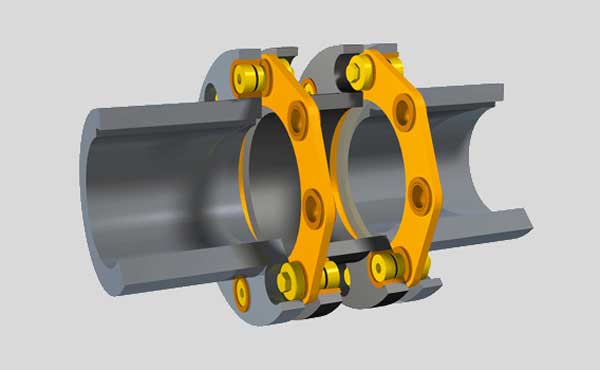 27.09.2013/XNUMX/XNUMX | Height screw tightening torques can become a real challenge when assembling large shaft couplings - especially in tight spaces. That is why Mayr Antriebstechnik has equipped the Roba-DS multi-plate clutch for high torques with an easy-to-assemble, form-fitting cone connection. This works with very low tightening torques. The five sizes of this series cover a nominal torque range from 22.000 to 110.000 Nm.
27.09.2013/XNUMX/XNUMX | Height screw tightening torques can become a real challenge when assembling large shaft couplings - especially in tight spaces. That is why Mayr Antriebstechnik has equipped the Roba-DS multi-plate clutch for high torques with an easy-to-assemble, form-fitting cone connection. This works with very low tightening torques. The five sizes of this series cover a nominal torque range from 22.000 to 110.000 Nm.
This will be the case with the Roba-DS with cone connection elastic disk pack connected positively and without play to the add-on parts such as hubs, flanges and sleeves. Externally conical bolts are pulled into the conical bores of the add-on parts and the collar bushings of the plate packs using clamping screws. The conical shape creates forces that expand the collar bushings and add-on parts radially and elastically, thus guaranteeing a backlash-free connection of the plate pack.
Dhey new cone connection reduces bolt tightening torques to a fraction compared to traditional friction-locked designs. This makes assembly and disassembly much easier. In addition, the units do not have to be moved to install and remove the clutch.
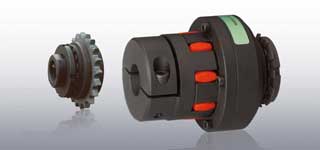 Slipping clutch and overload clutch limit torques
Slipping clutch and overload clutch limit torques
The Roba-DS shaft coupling is extremely robust, insensitive to high and low temperatures, extremely torsionally stiff and maintenance free. The multi-plate clutches transmit the torque backlash- and wear-free and compensate for axial, angular and radial shaft misalignments. In the case of two-joint versions, the length of the flexible component between the two disk packs can be varied to adapt to the shaft spacing. Due to their outstanding properties, multi-plate clutches are very well suited for applications with high torques. Customer-specific hubs and sleeves ensure a high level of flexibility.
Transmission
You can find the latest transmission innovations here.
Planetary gearbox archive
You can find the latest planetary gear innovations here.
- 22 mm planetary gear with up to 3,7 Nm torque
- Low-backlash planetary gear with torques up to 4600 Nm
- Overload-capable planetary gear with high efficiency
- Low-backlash planetary gear with helical toothing for high torques
- Double planet wheel bearing also for extreme situations
- Half the weight of the planetary gear for downsizing
- Flexible and powerful low-backlash planetary gear
- Energy-efficient standard gearbox that can be used flexibly
- Servo gears with 97 percent efficiency
22 mm planetary gear with up to 3,7 Nm torque
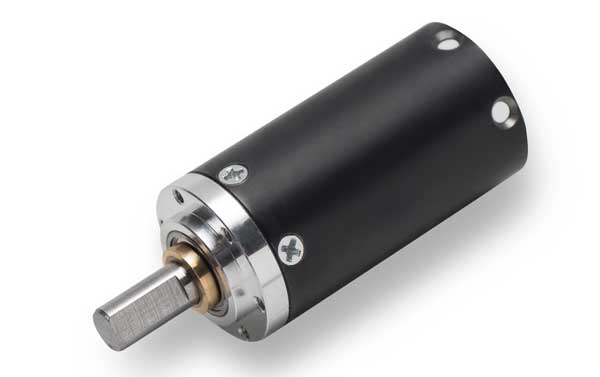 18.05.2017 | Portescap introduces the new 22mm high-torque planetary gearbox, featuring a fully geared design Metal and specially developed gears that have a continuous torque of up to 3,7 Nm and efficiencies in the range of 62 to 82% with a recommended maximum speed of 12.000 rpm-1 Offer.
18.05.2017 | Portescap introduces the new 22mm high-torque planetary gearbox, featuring a fully geared design Metal and specially developed gears that have a continuous torque of up to 3,7 Nm and efficiencies in the range of 62 to 82% with a recommended maximum speed of 12.000 rpm-1 Offer.
This gearbox can also be operated at higher than recommended maximum engine speed and speed within a certain power rating range (within limited duty cycles or times). As extensive reliability tests show, the R22HT is capable of a twice as high speeds achievable like previous products. The new transmission is available in 2 to 4 stages with ratios from 10,9:1 to 850,3:1. It can be used with 65 different gear ratios.
R22HT is suitable for applications such as electric grippers, medical analyzers, window ventilation actuators, medical equipment for physiotherapy, camera actuators and much more. Due to its high efficiency, R22HT is predestined for battery powered devices. Its lower weight and the mechanical equipment also ensure better ease of use with these devices.
Low-backlash planetary gears with torques of up to 4600 Nm
 19.03.2017 | William Vogel goes into series production with new sizes of its low-backlash MPR 400, 500 and 600 as well as MPG 400, 500 and 600 planetary gearboxes. They replace the previous sizes MPR-04 and MPR-05 or MPG-04 and MPG-05 and expand the torque range by up to 4600 Nm.
19.03.2017 | William Vogel goes into series production with new sizes of its low-backlash MPR 400, 500 and 600 as well as MPG 400, 500 and 600 planetary gearboxes. They replace the previous sizes MPR-04 and MPR-05 or MPG-04 and MPG-05 and expand the torque range by up to 4600 Nm.
Like their small series, they offer maximum flexibility and high power density. MPG and MPR differ significantly in the design of the output side. The MPR gearboxes have a free output shaft without feather key, they are optionally available with feather key or splined shaft DIN 5480.
The MPG have one at this point stable flanged shaft with a generous screw pattern. The position of the bolting surface to the roller bearings on the output is minimized in terms of design and thus enables high radial and axial load capacity. Thanks to their universal design, both series can be installed anywhere and have a simplified, flexible motor attachment. Users also continue to benefit from a large, consistent translation area.
Overload-capable planetary gear with high efficiency
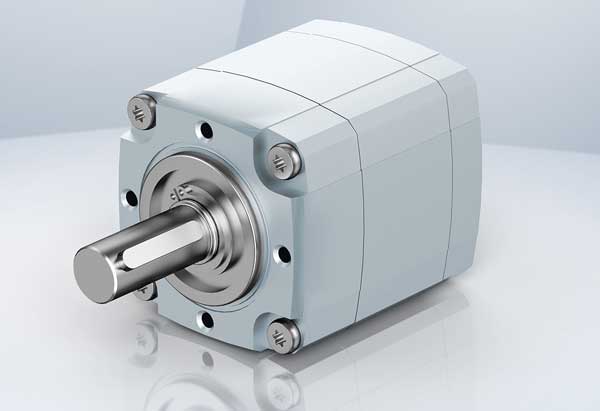 08.09.2015 | Applications in automation, intralogistics or mechanical engineering require powerful and compact drives. Ebm Pope offers a modular system for this, from which the user can put together the motor with the optimal gearbox for the respective individual case. For the upper power range up to 600 W, there is now a planetary gear with a high overload capacity in the form of the "Optimax 63". Whether continuous use or short-term peak loads, the gearbox is suitable for practically all areas of application.
08.09.2015 | Applications in automation, intralogistics or mechanical engineering require powerful and compact drives. Ebm Pope offers a modular system for this, from which the user can put together the motor with the optimal gearbox for the respective individual case. For the upper power range up to 600 W, there is now a planetary gear with a high overload capacity in the form of the "Optimax 63". Whether continuous use or short-term peak loads, the gearbox is suitable for practically all areas of application.
The Optimax transmission with protection class IP40 (optionally IP54) is very compact with a length of only 67,5 mm and a diameter of 78,5 mm. The optimized design of the planetary gears enables typical input speeds of 4000 rpm-1 Reductions from 3:1 to 45:1 and can provide short-term torques of 9 to 109 Nm at the output shafts, depending on the reduction.
This covers, for example, from pump drives via lifting and adjusting or sorting devices to dynamic turnstiles such as access systems a large number of areas of application in public buildings. Thanks to improved grease lubrication of the planet wheels, an efficiency of 30% per gear stage can be achieved over the entire temperature range from -40° to +90 °C. This noticeably extends the operating times of battery-powered mobile devices, and the operating noise and wear and tear are reduced at the same time.
Axial and radial loads of up to 40 N can be applied to the 500 mm long output shaft. That's how you can do it belt drives put on easily with pretension. Together with the electronically commutated ECI 63.xx -K1 or -K4 motors (nominal torque up to 0,85 Nm and short-term torque up to 2,6 Nm as well as nominal speeds of 4000 rpm-1) results in a drive unit that is maintenance-free via 20.000 h (L10) performs its duties reliably. It is suitable for a wide range of applications with high safety requirements up to applications with impact load or harsh environmental conditions. The wide range of reduction ratios, together with the scalable ECI motors, offers the user the possibility to select the drive exactly to his needs.
Low-backlash planetary gear with helical toothing for high torques
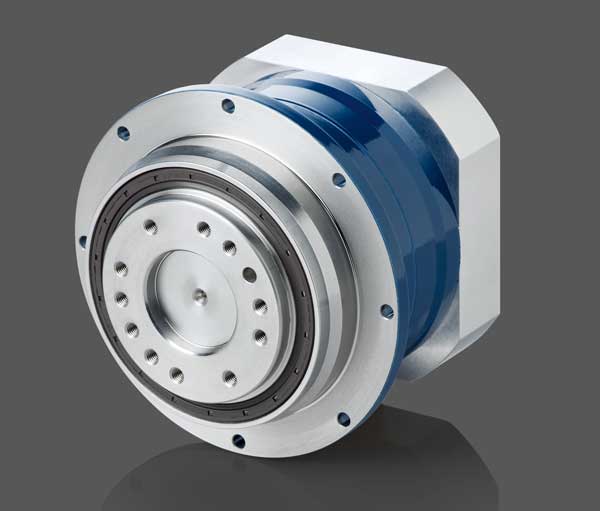 27.10.2014 | Vogel drive technology expands its two planetary servo gears series MPR and MPG with new sizes upwards. As early as 2007/2008, the drive specialist converted its low-backlash MPR series planetary gears to helical gearing, and in 2012 this conversion took place in the MPG series. Compared to spur gear concepts, they set new standards with significantly higher torques.
27.10.2014 | Vogel drive technology expands its two planetary servo gears series MPR and MPG with new sizes upwards. As early as 2007/2008, the drive specialist converted its low-backlash MPR series planetary gears to helical gearing, and in 2012 this conversion took place in the MPG series. Compared to spur gear concepts, they set new standards with significantly higher torques.
The new sizes MPR 400, 500 and 600 as well as MPG 400 and 600 replace the previous sizes MPR-04 and MPR-05 or MPG-04 and MPG-05 and expand the torque spectrum by up to 4500 Nm. Like their small series, they offer maximum flexibility and high power density. MPG and MPR differ significantly in the design of the output side.
The MPR gearboxes have a free output shaft without a feather key; they are optionally available with a feather key or with a splined shaft DIN 5480. The MPG have one at this point stable flanged shaft with a generous screw pattern. The position of the screwing surface to the Bearings at the output is structurally minimized and thus enables high radial and axial load capacity.
Thanks to their universal design, both series can be installed as required and have a simplified, flexible engine mounting. Users also continue to benefit from a large, consistent translation area. The low-backlash planetary gears are maintenance-free in sizes 050 to 300, low-maintenance in sizes 400 to 600 and, thanks to lubrication with synthetic high-performance oils, offer an above-average gear service life.
Double planet wheel bearing also for extreme situations
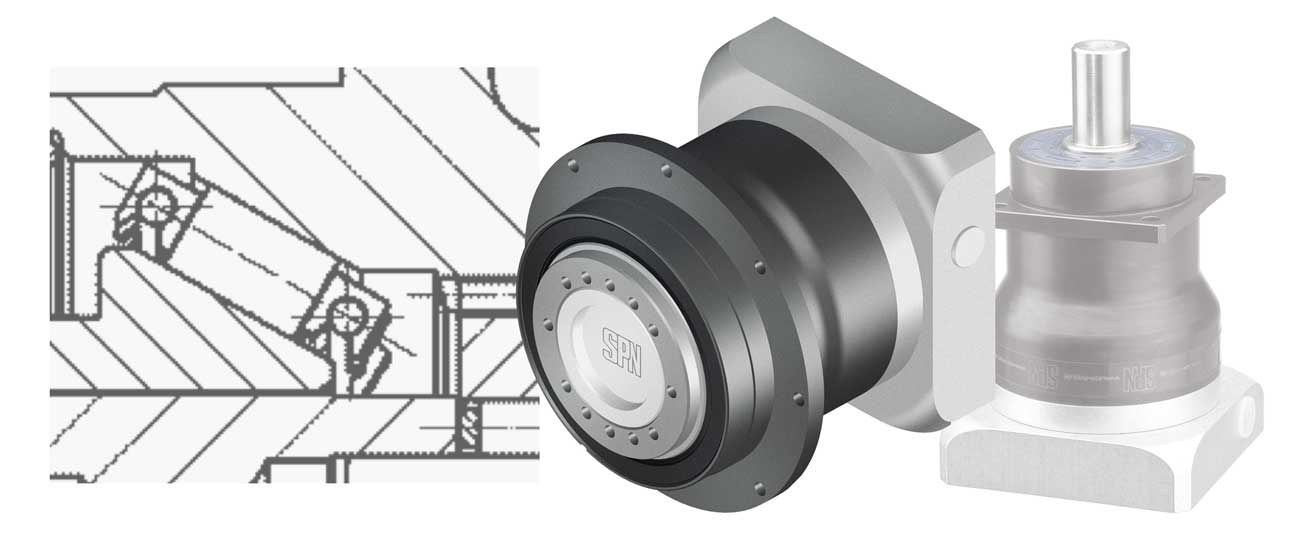
21.02.2013/XNUMX/XNUMX | The newly developed planetary gears RC4 series from SPN Swabia precision are characterized by optimal running smoothness, power density, bearing load capacity and rigidity. The RC4 series with flange is based on the already proven PU4 series with shaft. During development, the drive specialists concentrated on the criteria that are crucial for the power density of a planetary gear: gear geometry, bearings of planetary gears and output bearings.
The optimized helical gearing Due to the design, it includes the largest toothing width currently available on the market for standard catalog gears. In use, this leads to greater overload safety and maximum rigidity. At the same time, the 50% wider toothing of the planetary gear allows the accommodation of a double planetary wheel bearing. The absorption of the gear-internal tilting forces leads to increased running smoothness and bearing life.
The external forces introduced into the transmission are Output bearings arranged on both sides compensated. The directly integrated, space-saving inclined roller bearing enables a more compact design and thus leads to higher power density and rigidity. The RC4 and PU4 gear transmission series prove their worth even in extreme situations due to their overall performance.
Half the weight of the planetary gear for downsizing
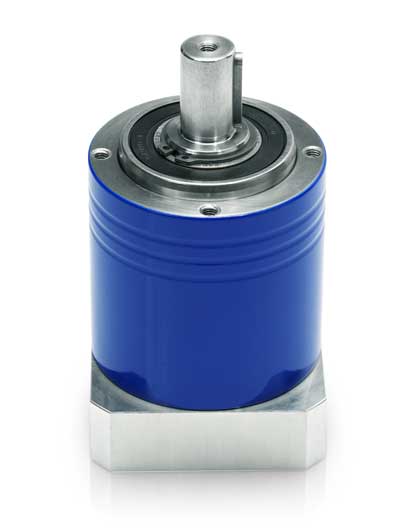 14.03.2012/XNUMX/XNUMX | The current trends in drive technology are noise reduction, energy efficiency and downsizing. Appropriately presented Wittenstein Alpha the third generation of the LP+ gear transmission series. The economical all-rounder now enables designers of feed axes and handling systems, packaging systems and general mechanical engineering to gain constructive and economic advantages through improvements.
14.03.2012/XNUMX/XNUMX | The current trends in drive technology are noise reduction, energy efficiency and downsizing. Appropriately presented Wittenstein Alpha the third generation of the LP+ gear transmission series. The economical all-rounder now enables designers of feed axes and handling systems, packaging systems and general mechanical engineering to gain constructive and economic advantages through improvements.
The transmittable torques are improved by up to 75% compared to the industry standard. By optimizing gearing parts and by a optimized tooth flank geometry the running noise could be more than halved. The user will be provided with the LP+ Generation offered three downsizing options.
Flexible and powerful low-backlash planetary gear
22.12.2011 | Vogel drive technology presents the MPG series, a further development in the area of low-backlash planetary gears. The aim of the new design was to combine maximum flexibility with high performance density. The gear drives are used in numerous industries: from classic mechanical and plant engineering to printing and packaging technology through to the areas of automation, handling and Robotic.
A small play and the optimization of the moment of inertia were in the foreground of the efforts. The new series is impressive reduced noise emissions, which is due to the improved concentricity and the product geometry with helical gearing.
As a result, compared to straight-toothed planetary gears up to 20% higher torque reached. This makes the new development particularly interesting for use with servo applicationsthat have a high speed range. The universal design enables simple and flexible motor attachment and also offers an above-average long service life for the gears. A large, consistent transmission range and lifetime lubrication with synthetic high-performance oils round off the overall concept of the MPG series.
Energy-efficient standard gearbox that can be used flexibly
 04.06.2010 | SPN Swabia precision has developed a versatile planetary gear. The E2 series is characterized by a particularly compact, simple and robust design. The "E" in the name of the series stands for "Economy". As with the previous E1 series, it was possible to achieve a low torsional backlash of just 10' (single-stage) or 15' (two-stage).
04.06.2010 | SPN Swabia precision has developed a versatile planetary gear. The E2 series is characterized by a particularly compact, simple and robust design. The "E" in the name of the series stands for "Economy". As with the previous E1 series, it was possible to achieve a low torsional backlash of just 10' (single-stage) or 15' (two-stage).
The gearbox is available in four sizes E22 to E25. Depending on the size, the output torque can reach up to 225 Nm. 13 gear ratios from i=4 single-stage to i= 100/two-stage are possible for each size. Another feature is maximum flexibility: "The aim of this new development was to expand our range of services with a versatile standard component in an attractive price category," says Anton Loesch, sales manager for transmissions at SPN. "Now we have a wide range of drive technology that is attractive for many interested parties and industries, from special gear construction to mechatronics and partial automation solutions to racks and various standard gears."
A special focus on the customer side for the compact, highly resilient gear transmissions is the Tooling, general mechanical and plant engineering. The selected standard flange dimensions for input and output are compatible with the flange dimensions common on the market. At the same time, the manufacturer is known for the fact that customer-specific output variants as well as special dimensions and designs are also possible.
Servo gears with 97 percent efficiency
 25.05.2010/XNUMX/XNUMX | The focus of the trade fair appearance Vogel drive technology is a series of low-backlash MPR planetary gearheads for servo applications. The MPR offers very high precision, low torsional backlash (1 arcmin. in the 3-stage standard version) and high torsional rigidity. The servo gear has a very high efficiency of up to 97% and thus enables extremely energy-efficient operation.
25.05.2010/XNUMX/XNUMX | The focus of the trade fair appearance Vogel drive technology is a series of low-backlash MPR planetary gearheads for servo applications. The MPR offers very high precision, low torsional backlash (1 arcmin. in the 3-stage standard version) and high torsional rigidity. The servo gear has a very high efficiency of up to 97% and thus enables extremely energy-efficient operation.
By combining a new part geometry with special helical gearing and a set of optimizations on the product and in the manufacturing process, a completely new device concept was created, which was recognized with the Innovation Prize of the Esslingen district as well as the Innovation Prize of the Initiative Mittelstand.
The special Modular system offers a high degree of individual options, such as 15 standard ratios, 4 sizes and numerous other options. In addition, "wash-down versions" are available, which are suitable for use in the area of packaging machines, food technology, pharmaceutical and chemical industries. Gear units with a special explosion-proof design (ATEX) are also available.
Linear Drives
Ball Screw Archives
The current ball screw innovations can be found here here.
Ball Screws 2019
- Precision ball screws with triple the service life
- Custom made ball screws and lockable ball rollers
- Ball screws with cooled nut for machine tools
- Customer-specific ball screws for precise positioning
Precision ball screws with triple the service life
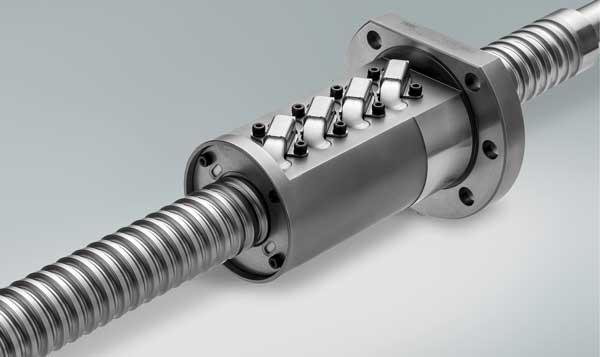 25.09.2019 | NSK introduces a new ball screw series that, among other things, at high stress reached about three times longer life. This is made possible by a special texture of the surface, which provides for improved oil film formation.
25.09.2019 | NSK introduces a new ball screw series that, among other things, at high stress reached about three times longer life. This is made possible by a special texture of the surface, which provides for improved oil film formation.
As a mechanical component, a ball screw is subject to wear. Among the constant development goals NSKResearch is to continuously reduce the minimal friction of the spindles, which is unavoidable for physical reasons, and thus increase the service life of these drive elements. There is a clear success to be recorded here, which has now been developed to the point where it is ready for series production.
At the beginning of the development there was the fact that typical damage patterns appeared on the surface of the screw drives Insufficient lubrication are due. The lack of lubrication in turn leads to direct metal-to-metal contact between the spindle and the nut. The spindles of precision ball screws are usually ground. Their surface texture appears under the microscope as streaks. Oil can run off easily in these micro-stripes, which can be a cause of insufficient lubrication at certain points.
Based on these findings, the manufacturer developed a new Surface treatment, which creates a flat texture with micro-indentations. The smallest amounts of oil can settle in these depressions and prevent insufficient lubrication both permanently and effectively. The nut thus constantly moves on a film of oil.
This technology reduces wear of a ball screw, especially for slow and short strokes. Compared to standard ball screws, this increases the service life by a factor of three. In addition, the new surface texture reduces break-away and stick-slip effects - even with small strokes and slow movements.
The new series is suitable e.g. B. for use in machine tools that perform high-precision machining processes and with which molds and tools are manufactured. Another application example are the linear drives from spark erosion systems. This series is also very suitable for grinding machines and similarly challenging applications.
The ball screws with the new surface texture are used in Inclines from 10 to 50 are available - in accuracies of C5 and better. The first samples are currently being used by users. Series production will start next year.
Custom made ball screws and lockable ball rollers
 14.08.2019/XNUMX/XNUMX | Rodriguez will be presented Ball Screw Portfolio with high precision in metric and imperial dimensions of the current standards for a wide variety of industries. With the diverse range of ball transfer units, heavy loads can also be moved easily, precisely and with minimal effort. A new addition to the portfolio is a ball transfer unit with integrated clamping.
14.08.2019/XNUMX/XNUMX | Rodriguez will be presented Ball Screw Portfolio with high precision in metric and imperial dimensions of the current standards for a wide variety of industries. With the diverse range of ball transfer units, heavy loads can also be moved easily, precisely and with minimal effort. A new addition to the portfolio is a ball transfer unit with integrated clamping.
Typical applications of ball screw spindles are, for example, adjusting, traversing and clamping devices in production and machine tools. in robots, Medical Technology or Semiconductor production these linear drives are ideal for dynamic positioning tasks in continuous operation.
The linear technology specialist delivers for customers with high precision requirements honed and whirled Ball screws with high accuracy. In our own high-performance production rolled ball screws made to measure in application-specific designs at economical conditions. Short delivery times are guaranteed even for screw drives made according to drawings.
Ball screw drives with high load ratings for heavy loads
The ball screw HLB series from Rodriguez offers a particularly high axial load capacity for heavy load. Suitable applications for this type of ball screw drive can be found, for example, in plastic injection molding machines, punching machines, electromechanical presses or electric lifting cylinders.
"The HLB ball screws are constructed like conventional drives," explains Jörg debts, Product Manager Linear Technology at Rodriguez. “However, they differ in their advanced nut technology. The nuts guarantee a high static load capacity of up to 4.800 kN. ”The HLB ball screw drive also has a compact Ball screw nut, develops little noise and offers high efficiency. The exact dimensions of the HLB ball screws can be flexibly adapted to the application.
The HLB ball screw is available in metric and imperial dimensions of the common industry standards. Ball screw nuts are offered in various designs. Rodriguez makes it in the own manufacturing also customized on its state-of-the-art machine tools. Thread drives manufactured according to drawings are supplied by Linear Technologyspecialist at economic conditions in a short delivery time.
The moving ones Ball transfer units from Alwayse are particularly suitable as a light conveying element in material flow technology. A total of 146 different variants of ball transfer units with load capacities from 10 to 5000 kg and a diameter of the balls between 4,8 and 120 mm solve almost every transport task. Ball transfer units with clamping options are new to the portfolio. The components, which are only 25 mm high, can be locked in place thanks to an integrated clamp.
Ball screws with cooled nut for machine tools
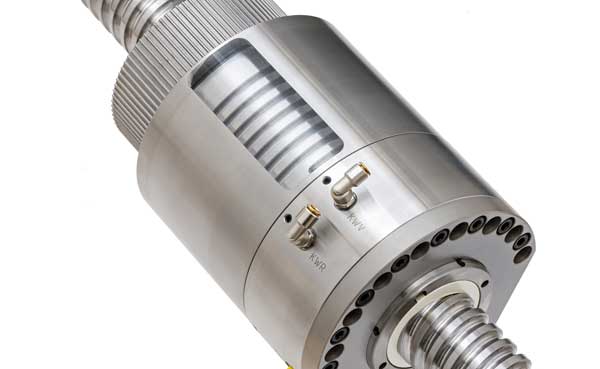 12.08.2019 | Kammerer thread technology has developed ball screws with cooled nuts for use in machine tools. The cooled nut allows for easier cooling of the ball screw. This sustainably improves the accuracy and service life of the screw drives and enables higher speeds and precision in the machine tools.
12.08.2019 | Kammerer thread technology has developed ball screws with cooled nuts for use in machine tools. The cooled nut allows for easier cooling of the ball screw. This sustainably improves the accuracy and service life of the screw drives and enables higher speeds and precision in the machine tools.
The choice of materials for the installed components was made with a view to thermal properties optimized. The thermo-symmetrical construction of the components and the thermal decoupling were taken into account. The cooling of the axes and machine can be variably controlled.
The spring loaded stretching the ball screws and the cooling bores in the spindle and nut minimize the displacement of the axes. The linear displacement of the axes is compensated by a direct path measuring system. In addition to low heat generation, the drives record low noise levels. The drive concept of the driven, cooled nut enables high linear speeds with a long effective stroke of the ball screws. In connection with a large incline, speeds of over 120 m/min can be achieved; under ideal conditions, speeds of up to 4000 rpm are possible.
Therefore, with long traverse paths, the Cycle times positively influenced become. The preloaded spindle system increases the overall rigidity of the drive train. The critical bending speed is not limited. Spindle accelerations of up to 30 m/s are possible. The use of hybrid bearings and ceramic balls can still increase existing speed limits. Ball screws with cooled nuts are available in sizes from 16 mm to 160 mm in diameter with different pitches.
Customer-specific ball screws for precise positioning

03.06.2019/XNUMX/XNUMX | Ball screws have been the ones in machine tools for decades preferably installed machine element, to move slides precisely and quickly. But like any mechanical element, they are also subject to constant wear and tear. If they have to be replaced at the end of their service life, long delivery times often result in high downtime costs for the affected machine. Dr. Tretter has the right solution in stock in many cases.
 Wear-free spindle nut made of plastic for heavy loads
Wear-free spindle nut made of plastic for heavy loads
become new CNC machines acquired, the decision-makers usually devote themselves to the machine equipment with great dedication. While the focus of interest is on the performance of the machine to be purchased, it is very often overlooked that it is only available for a certain period of time. The reason lies in the wear and tear of mechanical parts in daily use, which is noticeable, for example, in dimensional, surface and shape deviations of the workpieces.
Lifetime calculation and delivery times
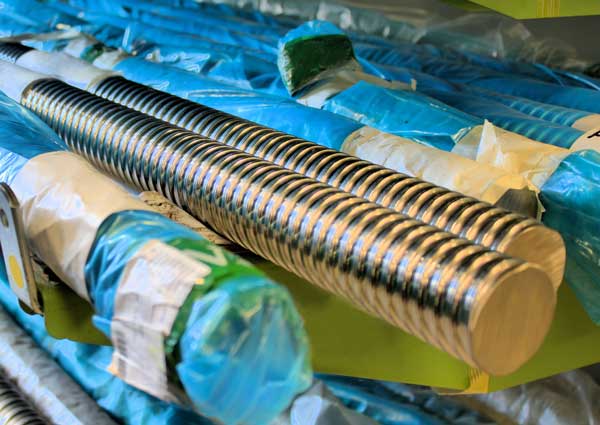 In the case of the ball screw spindles installed in machine tools, using sophisticated calculation programs whose lifetime can be determined fairly well. This data can form the basis for forward-looking procurement management in order to procure replacements for ball screws that are approaching the wear limit in good time. One hurdle, however, is the sometimes very long delivery times of between four weeks and 12 months. It is therefore not a bad idea to keep a set of ball screw spindles in stock when buying a new machine, so that they are immediately available in the event of service.
In the case of the ball screw spindles installed in machine tools, using sophisticated calculation programs whose lifetime can be determined fairly well. This data can form the basis for forward-looking procurement management in order to procure replacements for ball screws that are approaching the wear limit in good time. One hurdle, however, is the sometimes very long delivery times of between four weeks and 12 months. It is therefore not a bad idea to keep a set of ball screw spindles in stock when buying a new machine, so that they are immediately available in the event of service.
Unless the machine tool supplier has a well-stocked warehouse and guarantees the ability to deliver the ball screw spindle even after many years. However, if he gets into financial difficulties or there are other reasons, expensive ones to avoid machine downtimes. With the experts from Dr. Tretter is then in good hands when it comes to ball screws. Thanks to a large warehouse, the company is in many cases able to deliver the right ball screw without long waiting times.
Finished ballscrews and sold by the meter
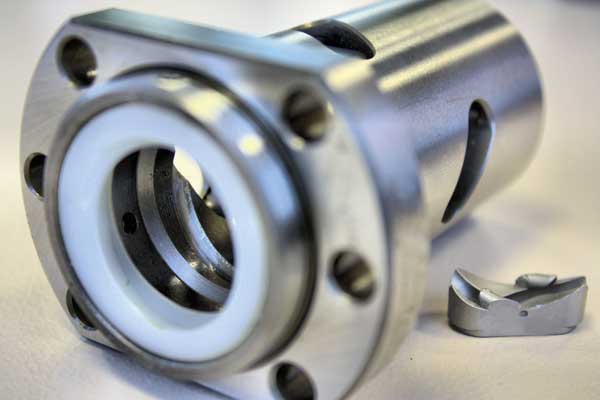 For this to work, are not exclusive finished ball screws reproached. Rolled spindles are produced from bulk goods and supplemented with nuts that are available from stock. Whirled spindles are individually manufactured according to drawings, while many types of ground spindles are even available from stock.
For this to work, are not exclusive finished ball screws reproached. Rolled spindles are produced from bulk goods and supplemented with nuts that are available from stock. Whirled spindles are individually manufactured according to drawings, while many types of ground spindles are even available from stock.
This procedure is just for special machine builder interesting, as this allows machines to be realized far from any dimensional constraints. In addition, the corresponding spindle can be selected precisely with regard to the intended use. For example, rolled ball screws are always recommended when positioning with the highest level of accuracy is not required.
This is the case, for example, in logistics. That achievable by rolled ballscrews Accuracy of 52 µm at 300 mm is completely sufficient for the handling machines used here. The remaining play also disappears completely when loads are moved vertically. Incidentally, rolled ball screws are cold-formed. Therefore, they do not have any broken fibers and have a very resistant surface structure.
Whirled, rolled or sanded
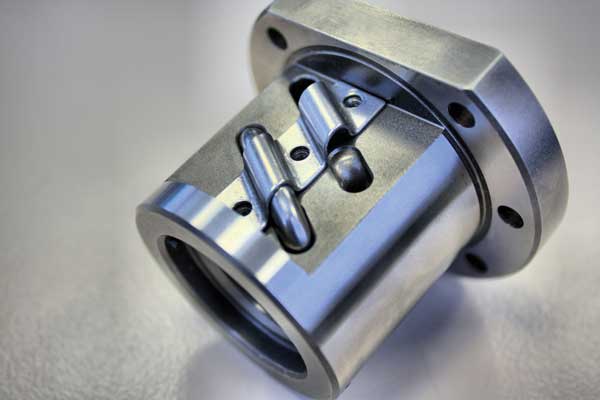 Whirled ballscrews are an opposite of the rolled versions higher quality variant. They are specifically used where expensive, ground ball screws would be uneconomical. With an accuracy of 23 µm at 300 mm, they are significantly more precise than rolled ball screws and are therefore suitable for applications where this level of accuracy is required.
Whirled ballscrews are an opposite of the rolled versions higher quality variant. They are specifically used where expensive, ground ball screws would be uneconomical. With an accuracy of 23 µm at 300 mm, they are significantly more precise than rolled ball screws and are therefore suitable for applications where this level of accuracy is required.
If even such accuracy is no longer sufficient, ground ball screws the right choice. These have an accuracy of 12 µm at 300 mm, which makes them ideal for use in high-precision machine tools.
The career for the balls is inductively hardened to 60 to 64 HRC, while the core is soft, so that the ball screw behaves elastically and yet has a high wear resistance.
In order to meet the high demands of machine tool manufacturers, a ball screw must run absolutely free of play. This is achieved, for example, by prestressing using a double mother. If little installation space is available, freedom from play can also be achieved by using balls that match each other exactly.
On the μ exact spheres
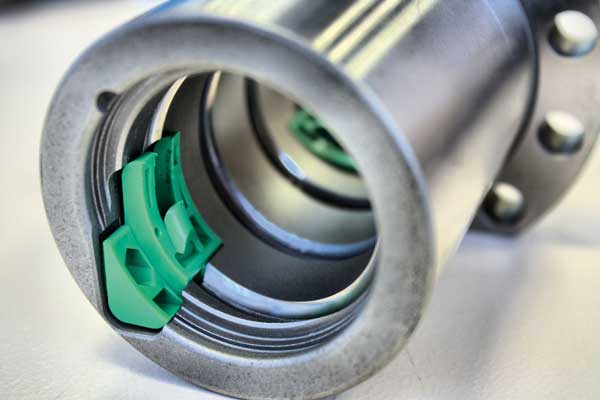 The special trick is to measure the diameter of each ball produced individually accurate to a thousandth of a millimeter to measure and to put together exactly the same balls in sets. From these sets, those balls are then put together that result in a play of exactly 0 mm or a preload. Alternatively, it would be possible to load balls without considering their precise diameter and then determine the remaining clearance. To eliminate them, one ball must then be exchanged for another one that has a larger diameter by the game.
The special trick is to measure the diameter of each ball produced individually accurate to a thousandth of a millimeter to measure and to put together exactly the same balls in sets. From these sets, those balls are then put together that result in a play of exactly 0 mm or a preload. Alternatively, it would be possible to load balls without considering their precise diameter and then determine the remaining clearance. To eliminate them, one ball must then be exchanged for another one that has a larger diameter by the game.
When installed, the filled balls run in a circuit within the ball nut, which is why the barrel is very smooth-running and the wear is distributed over all balls. The different ways in which the balls are moved in a circuit are interesting.
The so-called deflector system a ball revolution runs over an entire thread turn. Arriving at the end, the balls are transported back to the beginning of the corridor by a deflection piece. In the case of the deflection tube system, this return transport takes place via a deflection tube, while in the case of the end cap deflection system, return bores in an end cap are responsible for this.
Expert knowledge and what to look for
 Depending on the load to be moved, its acceleration and the desired service life, the experts at Dr. Tretter is able to use calculation programs to calculate the required size of the ball screw that matches the requirements. They also help with the selection of the right ball screw by Positioning accuracy, ask about the maximum travel speed and the desired service life.
Depending on the load to be moved, its acceleration and the desired service life, the experts at Dr. Tretter is able to use calculation programs to calculate the required size of the ball screw that matches the requirements. They also help with the selection of the right ball screw by Positioning accuracy, ask about the maximum travel speed and the desired service life.
The consultants also give tips from which materials the ball screw must pass so that it can function without problems in the environment in which it is used. For example, in the food sector, corrosion protection is absolutely necessary, while no plastics may be used in vacuum and clean room technology in order to prevent the emission of particles.
The Installation a ball screw should only be carried out by specially trained specialists, since ball screws are absolute precision parts that resent incorrect handling. For example, dropping the ball screw once can render it unusable. Under no circumstances should the nut be removed for assembly, as this could cause balls to deviate from their orbits and the ball screw must therefore be returned to the factory for assembly.
 Linear bearings for round shafts and fast movements
Linear bearings for round shafts and fast movements
Machine designers must ensure that the ball screw only axial forces picks up. A ball screw must not be used as a guide for the table. A coupling must be provided for torque transmission in order to avoid bending moments.
Machine operators must also ensure that the spindle regularly lubricated becomes. Under normal conditions, it is sufficient to check or top up the grease once a year. If it is a maintenance-free ball screw, this can of course be omitted.
Archive ball screw innovations 2018 to 2016
- Individual ball screws for every movement
- Ball screw with driven nut for machine tools
- increased service life with ball screw to 80 percent
Individual ball screws for every movement

17.06.2018/XNUMX/XNUMX | Linear guides and linear drives are used, for example, in machines and systems for loading and unloading processes or pick-and-place procedure installed. The motion sequences are as diverse as the areas of application - which is why they require individual solutions tailored to the application. The proven ball screws from the Rodriguez range are often used.
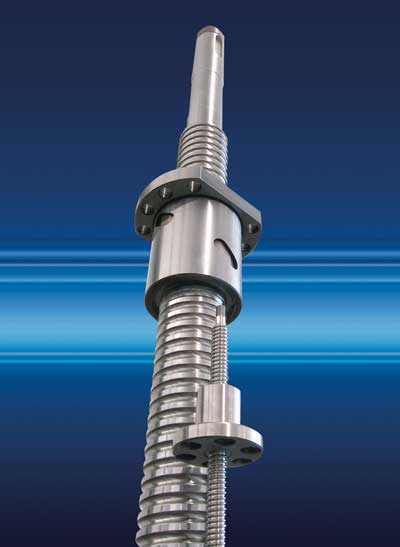 The wide range of linear technology from Rodriguez includes, among other things, round and profile rail guides, electric lifting cylinders, ball rollers and ball screws. The latter have always been an important part of the range: they are used to convert a rotary movement into a longitudinal movement. conventional Lead Screws consist of a threaded spindle and a threaded nut, the forces are transmitted via the thread flanks of the two components (sliding friction).
The wide range of linear technology from Rodriguez includes, among other things, round and profile rail guides, electric lifting cylinders, ball rollers and ball screws. The latter have always been an important part of the range: they are used to convert a rotary movement into a longitudinal movement. conventional Lead Screws consist of a threaded spindle and a threaded nut, the forces are transmitted via the thread flanks of the two components (sliding friction).
What ball screws can do
To Minimization of sliding friction threaded spindles and threaded nuts are often made of different materials. In the case of ball screw drives, on the other hand, rolling elements in the form of balls are responsible for the connection between the nut and the threaded spindle. These also transmit the force between the nut and spindle. Because of the rolling friction, there is a more favorable coefficient of friction, which in turn results in higher efficiency and lower drive torque and a longer service life.
The way food is heat generation is significantly lower, which enables correspondingly higher travel speeds. Ball screw drives are therefore typically used for dynamic positioning tasks in continuous operation, for example in adjustment, traversing and clamping devices in production and machine tools, but also in robot applications and medical technology or semiconductor production.
In many industrial applications, however, conventional ball screws are not fast enough because, particularly with very long ball screw spindles, the critical speed is reached. Driven ball screw nuts can help here. The combination of an adapted ball screw nut, axial angular contact ball bearing and precision groove nut results in an efficient, Timing belts driven unit that delivers optimal results even at high speeds. The linear technology specialist integrates a corresponding drive wheel at the customer's request.
Rodriguez supplies ball screws in metric and imperial dimensions of the common industry standards for the most diverse industrial sectors. Ball screw nuts are available in various designs. In its own production, which is equipped with various state-of-the-art milling and turning machines as well as high-performance machining centers, Rodriguez also manufactures application-specific, made-to-measure designs on economical terms and with short delivery times - even for those that are made to drawing.
The area is also developing Value Added Products (VAP) customized solutions based on ball screws. The tailor-made assemblies can fully meet the mechanical and control requirements defined by the application. The manufacturer selects the appropriate linear technology from the wide range and designs the assembly. This ensures that the solutions really do meet all of the customer's requirements.
Application examples from assembly and production
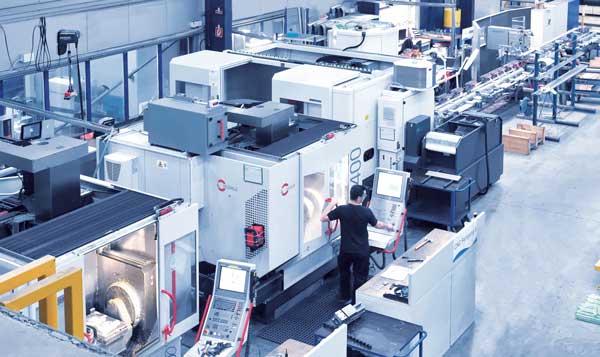 Customer-specific system solutions based on ball screw drives are very popular Pick and place-Applications, in the semiconductor industry or in packaging machines. But they also convince in other sectors:
Customer-specific system solutions based on ball screw drives are very popular Pick and place-Applications, in the semiconductor industry or in packaging machines. But they also convince in other sectors:
For example, Rodriguez designed a high-precision welded frame including mechanical conversion parts, which is used when printing ceramic surfaces. Among other things, ball screws and recirculating ball guides are installed here. The Eschweiler drive specialists took over the development, manufacture and assembly of production parts and drive components. The result: A sophisticated system solution from the field of linear technology, which contributes significantly to an optimal printing result.
But also when assembling aircraft parts made-to-measure products that do not correspond to any common standard are successfully used. The parts to be assembled are positioned in relation to one another with millimeter precision using cross tables that are embedded in the floor of the production hall and specially developed for this purpose.
In addition to a high load-bearing capacity, the solution is also characterized by the particularly low overall height of a maximum of 140 mm and high precision in the Reset to zero position by means of spring force (±0,5 mm). In addition to various steel components, profile rail guides and a combination of ball screws and springs were used on the drive side.
Ball screw with driven nut for machine tools
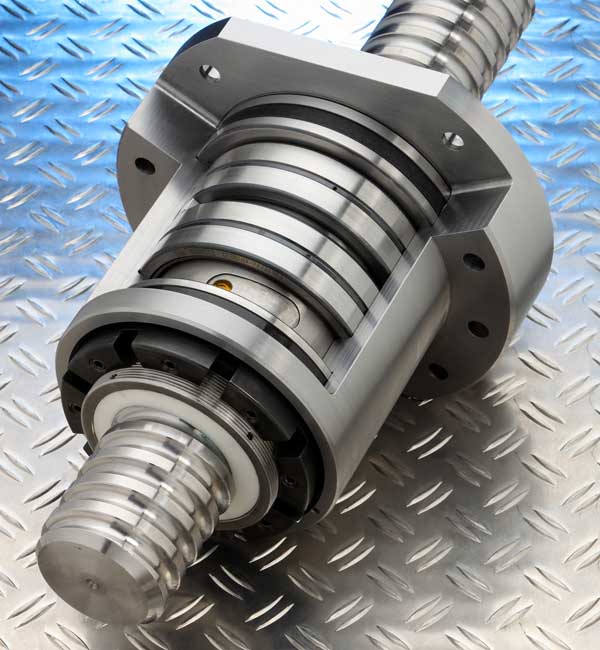 20.07.2017/XNUMX/XNUMX | Ball screws ensure in Machine Tools for moving the linear axes. The components actually have to meet conflicting requirements in terms of features such as speed range and precision, or performance and reliability. Because high accelerations and speeds with a long service life and reliability are actually contradictory. Kammerer combines the opposing requirements with its ball screws.
20.07.2017/XNUMX/XNUMX | Ball screws ensure in Machine Tools for moving the linear axes. The components actually have to meet conflicting requirements in terms of features such as speed range and precision, or performance and reliability. Because high accelerations and speeds with a long service life and reliability are actually contradictory. Kammerer combines the opposing requirements with its ball screws.
Especially for long axes like in portal milling machines Ball screw drives with a rotating nut are ideal because this drive concept enables high linear speeds with a long useful stroke. At a speed of 50 m/min, noise is much lower compared to other solutions. The manufacturing process of hard skiving of ball screws has been proven to reduce noise during operation. Heat development is also reduced, since spindle cooling is easier to implement when the spindle is stationary and the stationary nut housing can be easily cooled.
The driven mother concept has other advantages. Speeds of over 120 m/min can be achieved with the driven nut in conjunction with a large incline. Under ideal conditions, speeds of up to 4000 rpm are possible-1 possible. Therefore, the cycle times can be positively influenced for long distances. The higher dynamics cause an increase in productivity. The pre-tensioned spindle system ensures a higher overall rigidity of the drive train. The critical speed is not limited and the spindles can be accelerated up to 30 m / s².
existing speed limits can be achieved through the use of hybrid bearings and Ceramicsincrease balls. The drive concept can be modeled as a single-mass oscillator and can therefore be easily controlled. With large masses to be moved, this drive concept has better dynamic behavior. A spring-loaded spindle can compensate for the lengthening caused by the temperature change without losing the spindle stretch.
increased service life with ball screw to 80 percent
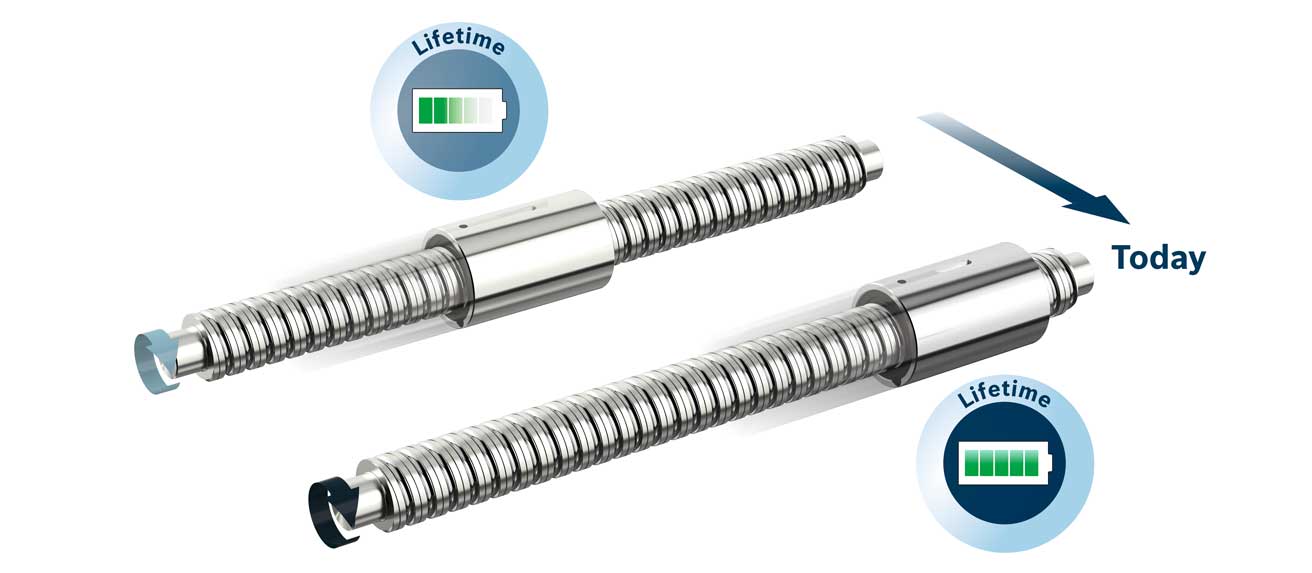
12.12.2016/80/XNUMX | Has an up to XNUMX% increased service life of the ball screws Bosch Rexroth achieved through continuously improved production processes. With the same performance requirements, designers can use smaller sizes as an alternative. At the same time, the manufacturer is shortening the delivery times for tailor-made screw drives by digitizing the engineering and ordering processes and optimizing logistics processes.
You rely on that cold-forming rolling process for spindle production. At the same time, the manufacturer has also further developed the manufacturing processes used in the manufacture of nuts. These improvements in both spindle and nut production increase the dynamic load ratings in accuracy classes T3 and T5 by 20%. The dynamic load rating is a key parameter for the design of the size and the service life of ball screws.
Comprehensive Load and life tests under a wide range of application scenarios validate the increase in service life. The increase in load rating also leads directly to an increase in power density. The company delivers the ball screws in Europe, for example, within three to five working days, sometimes even within 24 hours. The entire engineering and ordering process has been digitized throughout. Designers use the Linear Motion Designer (LMD) calculation tool to determine the right drives.
Ball screw 2014 to 2010
- Rolled, whirled or ground: ball and trapezoidal screw drives
- Ball screws for high speeds and positioning accuracy
- Feedback system for ball screws in machine tools
- Rolled ball screws for knitting machines
Rolled, whirled or ground ball and trapezoidal screw drives
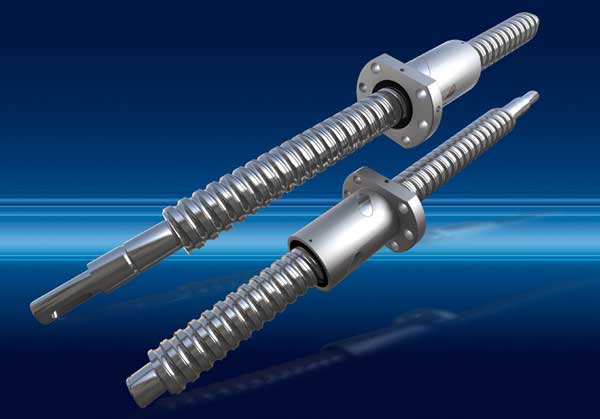 04.12.2014 | Ball screw drives are suitable for dynamic positioning tasks in continuous operation, while trapezoidal screw drives are suitable for slow transport tasks and voltage tasks with a short duty cycle. The portfolio of Rodriguez includes both standard and special versions of the threaded spindles for every conceivable positioning task. Ready-to-install assemblies based on threaded spindles can also be manufactured on request.
04.12.2014 | Ball screw drives are suitable for dynamic positioning tasks in continuous operation, while trapezoidal screw drives are suitable for slow transport tasks and voltage tasks with a short duty cycle. The portfolio of Rodriguez includes both standard and special versions of the threaded spindles for every conceivable positioning task. Ready-to-install assemblies based on threaded spindles can also be manufactured on request.
Thanks to her special construction With balls as rolling elements, these screw drives have a very high level of efficiency and are therefore very well suited for dynamic positioning tasks in continuous operation. A typical application example is the exact positioning of the block of wood on the peeling axis of a rotary peeling machine. Here, for example, ball screw drives of size 50 x 10 with accuracy class 5 are used. They allow a maximum pitch deviation of 23 µm over 300 mm.
Depending on the application requirements, the manufacturer supplies ball screws with single, double and special nuts in a wide variety of designs – with or without preload, single or multi-threaded. In our own production, application-specific versions are made to measure with short delivery times, even for drives made to drawings. In particular, the common sizes of the rolled screw drives in the accuracy classes C9 and C7 with mounted single flange nut according to DIN are available at short notice.
In many industrial applications, speed is a hurdle for traditional ball screws. The longer the ball screw, the higher the risk that the desired speed will not be reached due to the limitation of the critical speed of the spindle is not reached. The ball screw drive combination with driven ball screw nut, axial angular contact ball bearing and precision slotted nut results in a powerful, toothed belt-driven unit that delivers optimal results even at high speeds. A corresponding drive wheel can also be integrated on request.
Lead Screws for tension tasks and slow transport work with sliding friction that is lower than with standard ISO threads. They are suitable for tasks that do not place great demands on positioning accuracy and demonstrate their advantage of self-locking, especially when used as a Z axis. However, due to the permanent friction losses, their efficiency is lower than that of ball screw drives, as is the feed rate. For this reason, trapezoidal threads are mainly used for slow transport or voltage tasks with a low duty cycle. Typical applications are as a drive element in milling machines and lathes, in backlash-free positioning systems, automatic lifting presses and other lifting mechanisms, for example in the food industry.
Ball screws for high speeds and positioning accuracy
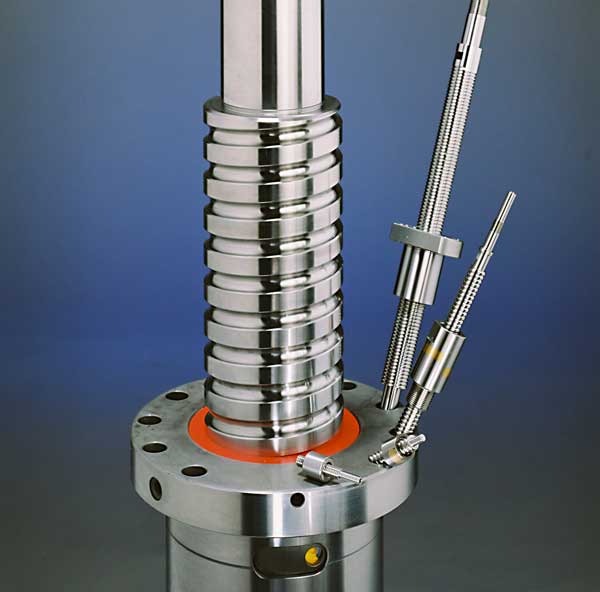 18.08.2011 | Kammerer thread technology introduces a complete line of ball screws. This is characterized by high positioning accuracy and is suitable for high speeds.
18.08.2011 | Kammerer thread technology introduces a complete line of ball screws. This is characterized by high positioning accuracy and is suitable for high speeds.
From Miniature ball screws The products are used in general and machine tool construction, handling automation and robotics, precision engineering and medical technology as well as in vehicle and aircraft construction.
A new ball deflection system ensures smoother running, even at high speeds, thanks to an optimized coefficient of friction.
For high speeds with a long useful stroke, there are components with a driven recirculating ball nut. The screw drives are offered in the accuracy classes IT3, IT5, IT7 and IT10 according to DIN 69051.
you will in finely peeled and ground version manufactured with diameters from 4 to 160 mm. Depending on the manufacturing process, the spindles can be made in one piece up to a length of 8 m; on request also up to 15 m and other special versions can also be realized.
Feedback system for ball screws in machine tools
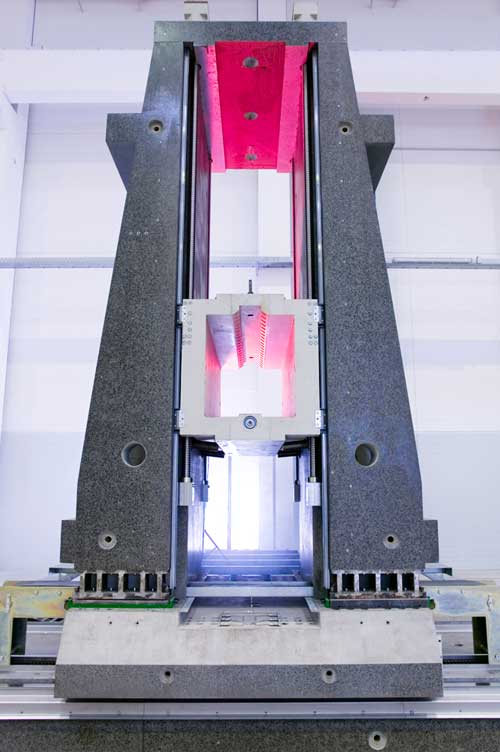 12.07.2011 | Kammerer thread technology presents a novel feedback principle for high-performance ball screws in machine tools (WZM). The ball return system reduces noise and internal friction in the screw drive ball chain. It is being developed as part of a research cooperation project in which the Institute for Production Engineering of the Karlsruhe Institute of Technology (KIT) is also involved. The aim of the project is the construction of system components for the WZM construction.
12.07.2011 | Kammerer thread technology presents a novel feedback principle for high-performance ball screws in machine tools (WZM). The ball return system reduces noise and internal friction in the screw drive ball chain. It is being developed as part of a research cooperation project in which the Institute for Production Engineering of the Karlsruhe Institute of Technology (KIT) is also involved. The aim of the project is the construction of system components for the WZM construction.
As a further cooperation partner, the company develops E. Reitz natural stone technology a new type of cement-bound concrete (UHPC) as the material for manufacturing the machine bed on which the ball screw is mounted. The interaction of ball screw drive and machine bed in terms of damping, rigidity, temperature variation and other parameters is currently being researched at KIT. The reference is a conventional machine bed designed as a welded steel construction, which is available in the same dimensions for comparison.
"With the combination of machine bed and drive technology from a single source, we want to meet the demands of some machine manufacturers who want a complete system," explains Peter Kammerer, technical director of the Hornberger thread technology specialist. “The discussions in drive technology show that there is still development potential for ball screws and that this must also be realized in order to strengthen the ball screw as a drive element. Because despite alternative drive technology, the ball screw drive is still regarded as the most important drive element in machine tools.”
Rolled ball screws for knitting machines
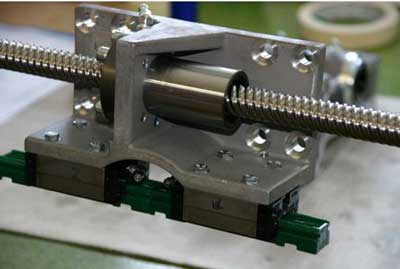 07.09.2010 | Eichenberger manufactures niche products: In Switzerland, EAG is the only manufacturer of rolled ball screws, and one of the few producers of high helix spindles worldwide. Eichenberger's technology has proven itself in ropeway construction for decades: rolling the threads of the suspension bolts for thousands of ropeway gondolas. This technology is now also finding its way into the "normal" ball screw sector, as the example of high-tech knitting machines shows:
07.09.2010 | Eichenberger manufactures niche products: In Switzerland, EAG is the only manufacturer of rolled ball screws, and one of the few producers of high helix spindles worldwide. Eichenberger's technology has proven itself in ropeway construction for decades: rolling the threads of the suspension bolts for thousands of ropeway gondolas. This technology is now also finding its way into the "normal" ball screw sector, as the example of high-tech knitting machines shows:
In contrast to hand embroidery, the embroidery machine not the needles, but the whole length of fabric. The reason: Only one movement is needed to move the stretched fabric in the X and Y axes. If you wanted to control thousands of embroidery needles, you would need thousands of adjustment drives. In concrete terms, this means that the fabric is moved back and forth and up and down with high speed and precision. With the «Epoca 1» 04-stack embroidery machine, these so-called gate movements, which are responsible for positioning the fabric, result in the highest embroidery quality.
For the drive, the factors of accuracy, simplicity as well as costs and robustness spoke for a ball screw (KGT), especially for the vertical travel. For these reasons, the ball screw drive (KGT 25 x 25) with four ball returns was chosen. Installing the spindle is easy: the gear is integrated in the nut body. The conversion of the rotary movement into a longitudinal movement is precise and free of play.
Problem play in the knitting machine
But an "ordinary" KGT over 2 m long would required freedom of play not reach. Because the mother always has a certain amount of play, that's how physics wants it. In most applications this is irrelevant. In special cases, however, this game has a devastating effect. This is also the case in the embroidery machine: to move the length of fabric, the spindle nut moves up – but a bit too much, the control “says”: two micro-steps back. If there was too much “game in game”, the steps backwards will come to nothing. The result is an unusable pattern. This would be particularly important when reversing the direction of movement. If accelerations of more than 1 g occur when moving the nut in the Y-axis, the nut wobbles on the spindle.
 Intelligent CNC control for new + old machine tools
Intelligent CNC control for new + old machine tools
To pick up this game you don't have to use the usual system two nuts tightened against each other resorted to, but uses a special construction: A single nut that combines a very short design with high rigidity. The preload is generated by a special thread profile on the spindle on a Gothic basis.
Engines
Stepper Motor Archive
You can find the latest stepper motor innovations here.
- Uniform communication with gateway for stepper motor drives
- Stepper motor controller for transport or belt drives
- Chip prevents blocking of the motor - video statement
- Integrated stepper motor drives with Modbus TCP
Uniform communication with gateway for stepper motor drives
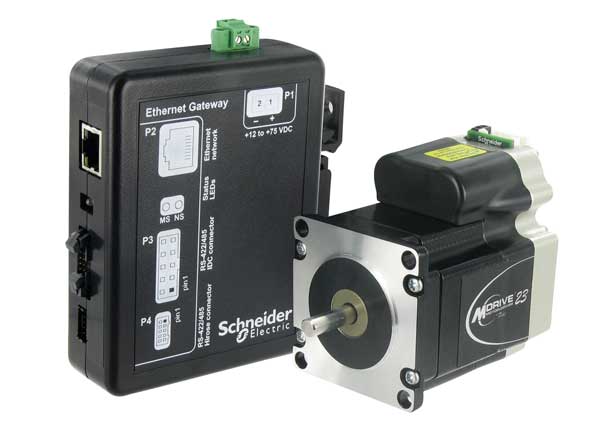 30.12.2012/XNUMX/XNUMX | Koco Motion presents at the autumn fairs Motek and SPS/IPC/Drives another innovation for its integrated "MDrive" stepper motor drives and the "Mforce" stepper motor controllers with serial RS485/422 interface and ASCII command set: with the new Ethernet gateway these can now be integrated into Ethernet-based bus and fieldbus systems.
30.12.2012/XNUMX/XNUMX | Koco Motion presents at the autumn fairs Motek and SPS/IPC/Drives another innovation for its integrated "MDrive" stepper motor drives and the "Mforce" stepper motor controllers with serial RS485/422 interface and ASCII command set: with the new Ethernet gateway these can now be integrated into Ethernet-based bus and fieldbus systems.
Gateways serve generally the translation and connection of existing interface protocols to other interfaces and fieldbus systems. When using the ODVA (Open Devicenet Vendor Association), the user selects an EthernetGateways via the RJ45 port settings to which Ethernet protocol the Mcode ASCII command set of the RS485/422 interface is to be converted. The protocols Mcode over Ethernet, Modbus TCP or Ethernet/IP can be selected.
With the gateway, a large number of controllers and integrated stepper motors can now be used in applications Ethernet build based networks. This enables consistent and uniform communication in the most diverse drive tasks of a machine.
 BLDC motor for high noise and long runtime
BLDC motor for high noise and long runtime
The integrated stepper motor drives Mdrive Plus and Mdrive Hybrid with motor size Nema 23 are in the programmable version Motion Control equipped with an Ethernet/IP interface. The IP address and the various parameters and objects for communication are set on the Mdrive drives via a configuration program. They can then be easily integrated into the corresponding Ethernet/IP networks together with other devices and components.
the interface Modbus TCP in the stepper motor drives Mdrive Plus and Mdrive Hybrid with motor size Nema 23 is also available in the programmable Motion Control version. Thanks to the simple and proven Modbus RTU protocol, the Mdrive drives can be connected to appropriate controls or IPC integrate easily.
These integrated stepper motor drives are suitable for a wide range of positioning applications for example in Automation services, Measurement Technology or Medical Technology. They can be integrated very easily and quickly into the application.
Stepper motor controller for transport or belt drives
 04.12.2012 | Koco Motion presents its new stepper motor controller DM805-AI with analog speed input up to 5 A rated current. It was designed for applications such as transport and belt drives, in which stepper motors have different speeds up to a maximum speed of 25 s-1 must drive exactly, without being driven by an external clock generator.
04.12.2012 | Koco Motion presents its new stepper motor controller DM805-AI with analog speed input up to 5 A rated current. It was designed for applications such as transport and belt drives, in which stepper motors have different speeds up to a maximum speed of 25 s-1 must drive exactly, without being driven by an external clock generator.
Supply voltages of up to 80 V and adjustable phase currents of up to 5 A allow the use of stepper motors with a flange size of up to 86 x 86 mm Nema 34 and with torques of more than 10 Nm.
The microstep resolutions, the motor current and the various operating modes can be selected via DIP switches. Even with a setting for low microstep resolutions, up to 512 microsteps are run. As a result, very good running properties are achieved and especially at low speeds Direct drive without Transmission a very good run.
In addition to the classic cycle/direction operation, two different speeds and the acceleration ramp, i.e. the acceleration of the motor to the set speed, can be set in the operating modes. The two speeds are then selected and approached via the appropriate inputs. In addition, a Potentiometer or an external analog voltage of 0...5 V DC generate a speed reference with which the motor speed can be continuously adjusted. Depending on the mode, it rotates either only at the two preset speeds via the switch or digital inputs or infinitely adjustable via the analog input.
An even more extensive parameterization with very far-reaching tuning functions such as resonance suppression and offset settings, the serial interface RS232 allows if it is configured via the "ProTuner" software. The DM805-AI stepper motor control is already available in small quantities from stock.
Chip prevents blocking of the motor - statement
11.10.2011/XNUMX/XNUMX | At this year's Motek, Koco Motion is presenting the Mdrive hybrid Stepper motor that behaves like a brushless DC motor thanks to a chip. Gerhard Kocherscheidt, Managing Director, Koco Motion the, Dauchingen presents this and other highlights of the fair.
Integrated stepper motor drives with Modbus TCP
12.10.2011 | Koco Motion presents innovations from its portfolio of highly integrated electric drives and motion control products. A highlight is the new interface Modbus TCP in the proven integrated stepper motor drives "Mdrive Plus" and "Mdrive Hybrid". It is available in the programmable Motion Control version and promises to be an insider tip.
Along with Profinet IO, Ethernet/IP, Ethercat and Powerlink, Modbus TCP has established itself as a industry standard established for industrial communication. Based on Ethernet TCP/IP data transmission, Modbus TCP is becoming increasingly popular among Industrial Ethernet networks. This development is based on the simple and tried-and-tested Modbus RTU protocol, with which the Mdrive drives can be easily integrated into corresponding controllers or IPCs.
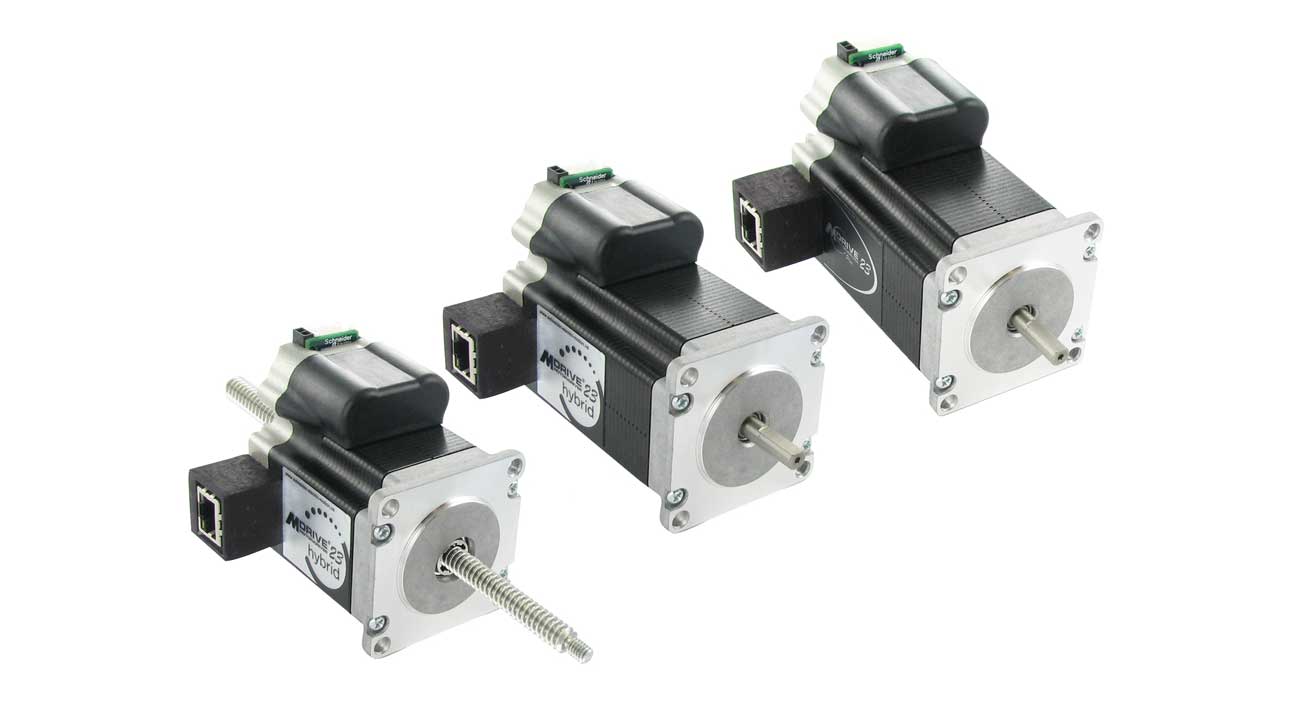
The integrated high-resolution microstepping control with up to 51.200 microsteps per revolution enables very precise movements and positioning. External sensors, limit switches, etc. can be connected directly to the inputs/outputs that are also integrated.
The patented Closed loop control Hybrid Motion Control (HMI) prevents the "stalling" typical of stepper motors in the Mdrive hybrid drives. In the event of an overload, the HMI uses the integrated encoder to reduce the speed to a standstill if necessary. The motor thus behaves like a DC servo drive and therefore no longer has to be correspondingly oversized. Four motor lengths are available in the motor flange size Nema 23 (56 x 56 mm). The maximum torque is 2 Nm. There is also a version as a linear actuator with trapezoidal thread spindle.
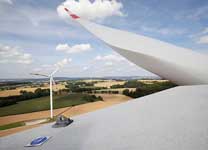 Sensor technology protects WKA rotor blade from ice and damage
Sensor technology protects WKA rotor blade from ice and damage
These integrated stepper motor drives are suitable for a variety of positioning applications, for example in automation technology, measurement technology or medical technology. In doing so, they let themselves go integrate quickly and easily into the application.
Archive for servo motors
You can find the current servo motor innovations here.
Servo motors 2019 to 2017
- Short BLDC servomotor with 16 mm diameter
- Highly dynamic servomotors for the harsh environment
- Servo motors with digital Hiperface DSL interface
- BLDC servo motor for lightweight construction with 59 mNm torque
- Kannmotion servo motor system 1.0
Short BLDC servo motor with 16mm diameter
 02.05.2019/1645/XNUMX | The brushless DC servo motor XNUMX ... BHS from Faulhaber offers extremely short response time, high speed and large permissible radial load. It expands the BHx series with a diameter of 16 mm with an even more compact variant that is only 45 mm long. In addition, this extremely powerful BLDC motor causes only little vibration and heat generation. This makes it suitable for applications with high power requirements and tight installation spaces.
02.05.2019/1645/XNUMX | The brushless DC servo motor XNUMX ... BHS from Faulhaber offers extremely short response time, high speed and large permissible radial load. It expands the BHx series with a diameter of 16 mm with an even more compact variant that is only 45 mm long. In addition, this extremely powerful BLDC motor causes only little vibration and heat generation. This makes it suitable for applications with high power requirements and tight installation spaces.
The BHx series consists of gapless, brushless, high-performance motors in two-pole technology. At around 1645 rpm, the 100.000 … BHS variant achieves a significantly higher speed than the motors of this size previously available on the market. It also shows top values at maximum radial load (1 N), power density (18 W) and torque (58,5 mNm). With a matching one planetary gear the engine can already deliver a very high torque of 12.000 mNm at 1 rpm.
A pair of Efficiency of 90% allow the motor to work in a very energy-efficient manner. It achieves its extremely short reaction time thanks to extremely low values for the mechanical start-up time constant and rotor moment of inertia, as well as a very fast angular acceleration. Together with the flat gradient of the n/M characteristic curve (429 min-1/mNm), this results in optimal running behavior of the motor, which therefore follows fluctuating power requirements without delay.
Digital hall sensors are integrated, an integrated incremental encoder is possible as a special version. A wide range of connection components such as speed and motion controllers, controls and gears are available for different types of use. Typical areas of application are, for example, electrical robot gripper, small handpieces, robotic systems, laboratory automation or mechatronic instruments of all kinds.
Highly dynamic servomotors for the harsh environment
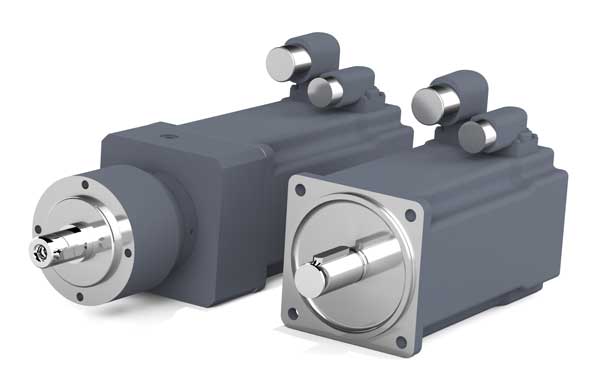 03.08.2018/3/XNUMX | Highly dynamic movement tasks are the target area of the servo motors in the new DLXNUMX series from KEB. The version with special epoxy coating Steel IT is well prepared for installation positions with direct weather influences and use with light chemical stress on the surface from the environment.
03.08.2018/3/XNUMX | Highly dynamic movement tasks are the target area of the servo motors in the new DLXNUMX series from KEB. The version with special epoxy coating Steel IT is well prepared for installation positions with direct weather influences and use with light chemical stress on the surface from the environment.
There are 5 motor sizes from 55 to 190 mm with nominal torques from 0,5 to 70 Nm to choose from for different requirements in machines and systems. as servo geared motors in combination with the 1- and 2-stage planetary gearn for adjusting torque and speed are available in the special coating for 4 motor sizes with output torques from 5 to 720 Nm. The range of gear ratios ranges from i=5 to i=40.
The fitting Combination of motor and planetary gear as well as the assignment of the correctly dimensioned servo controller "Combivert S6" can be operated with just a few clicks in the module configuration in the "Combivis 6" service tool. The system selection of motor, gearbox, servo controller and the associated cables is done graphically or in tabular form. The software provides all the technical documentation for design, installation and commissioning.
Servo motors with digital Hiperface DSL interface
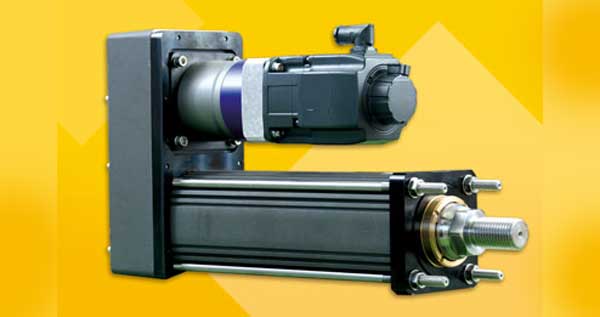 30.01.2018 | A drive offers its highly dynamic servo motors of the SMN series with a digital Hiperface DSL interface. Another innovation are encoders with a Drive-Cliq interface, which can be very easily integrated into existing automation systems. This has many advantages with the electric actuating cylinders and makes the actuators even more intelligent.
30.01.2018 | A drive offers its highly dynamic servo motors of the SMN series with a digital Hiperface DSL interface. Another innovation are encoders with a Drive-Cliq interface, which can be very easily integrated into existing automation systems. This has many advantages with the electric actuating cylinders and makes the actuators even more intelligent.
The highly dynamic servomotors of the Series SMN there is now a one-cable solution SMNH with Hiperface DSL. Hiperface DSL corresponds to the RS485 standard with a transfer rate of 9,375 Mbaud. The data is transmitted synchronously with the controller cycle, which can be as short as 12,1 µs. The cable length between speed controller and feedback system can be up to 100 m. An additional structure or an extended connection housing is no longer necessary for the small servo drives.
Thanks to the digital protocol, servo motors can keep up Hiperface DSL with a minimum of connecting cables. With this one-cable solution, sensor and encoder data are transmitted or modulated via separate wires. With servo motors with Hiperface DSL, design engineers benefit from the electronics integrated in the motor and the signal transmission as a data protocol. This makes intelligent, self-optimizing and consistently networked drive systems possible.
 BLDC motor for smooth running and long runtime
BLDC motor for smooth running and long runtime
By disclosing the system interface Drive Cliq servo motors and actuators can now also be equipped with appropriate encoders. This means that the parameterization and control data is exchanged automatically between the automation system and the actuator, so that commissioning is significantly simplified.
BLDC servo motor for lightweight construction with 59 mNm torque
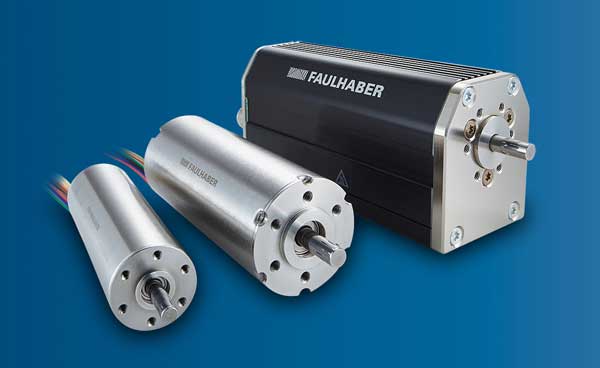 05.05.2017 | Faulhaber expands the powerful BP2264 product family with the brushless DC servo motor 4…BP4. The four-pole motor achieves a torque of 59 mNm with a weight of only 140 g and a diameter of 22 mm. It also manages up to 34.500 min-1, The reason for the high performance, the new segment-winding of the coil, which is designed for brushless DC motors of BP4 family.
05.05.2017 | Faulhaber expands the powerful BP2264 product family with the brushless DC servo motor 4…BP4. The four-pole motor achieves a torque of 59 mNm with a weight of only 140 g and a diameter of 22 mm. It also manages up to 34.500 min-1, The reason for the high performance, the new segment-winding of the coil, which is designed for brushless DC motors of BP4 family.
Thanks to the overlapping, nested, individually wound segments, a particularly large amount of copper can be accommodated in the coil. The desired side effect is large winding symmetry with minimal losses and correspondingly high efficiency.
Thanks to the compact spool, there is space for a heavy-duty shaft with a diameter of 4 mm and suitable bearings. With his low moment of inertia the motor is well suited for dynamic start/stop operation. It can also be overloaded, works without wear-prone mechanical commutation and therefore has a service life that is many times longer than that of conventional DC micromotors. It can be used at temperatures between -40° and +125 °C.
integrated analog Hall sensors as an option can replace an encoder in most applications and determine the position of the output shaft very precisely. Compatible optical and magnetic encoders are also available for high-precision applications. The motor is suitable, among other things, for industrial automation and handpieces for electric tools.
Kannmotion servomotors generation 1.0
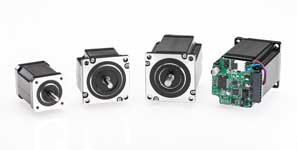 03.02.2017 | In 2016, Koco Motion received an inquiry from a Swiss manufacturer of analysis equipment who was looking for a drive solution for a major project. The built-in valve control for analyzers led the companies Adlos, as a controller developer and koco Motion together as a drive specialist. In order to meet the requirements, both companies developed a solution tailored to the application Stepper Motor Control System.
03.02.2017 | In 2016, Koco Motion received an inquiry from a Swiss manufacturer of analysis equipment who was looking for a drive solution for a major project. The built-in valve control for analyzers led the companies Adlos, as a controller developer and koco Motion together as a drive specialist. In order to meet the requirements, both companies developed a solution tailored to the application Stepper Motor Control System.
Servo motors 2016 to 2014
- Servo drives as an alternative to hydraulics and pneumatics
- Servo motor with precision gear saves up to 50% installation space
- Compact synchronous servo motor with high dynamics
- Direct drives and servomotors with Industrial Ethernet
- Low-maintenance servo drives for automatic screw feeding
Servo drives as an alternative to hydraulics and pneumatics

13.10.2015 | Linear drives are a focus of the trade fair appearance at ESR Pollmeier. Linear actuators and tubular Linear motoren are presented as replacements for hydraulics and pneumatics. Together with the new generation of servo controllers, the company offers drive packages for easy switching in the range from 0,2 to 15 kW.
The robust linear actuators are called clean alternative to Hydraulic cylinders used in applications where high forces and rapid load changes are important. As a replacement for pneumatic cylinders, the tubular linear motors offer an economical and flexible solution for highly dynamic positioning tasks.
In addition, the drive specialist has linear drives based on spindles, Timing belts or linear motors of classic design in the program. There are motor-gear combinations and for rotary applications torque motors. This allows the user to use all the advantages of servo technology to position quickly, precisely and powerfully, such as in handling and assembly or with measuring machines and test benches.
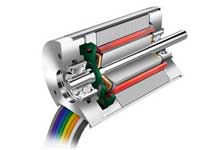 BLDC motor: when the DC motor reaches its limits
BLDC motor: when the DC motor reaches its limits
There is a matching one servo controller of the new generation with integrated safety technology and direct mains connection in the power range from 0,2 to 15 kW. The drive packages are suitable for stand-alone solutions with an operator terminal and for use in automation systems. The servo drives will be shown in action at the booth. The integration options for servo drives in Industry 4.0 will also be presented on the basis of the common Industrial Ethernet variants.
Servo motor with precision gear saves up to 50% installation space
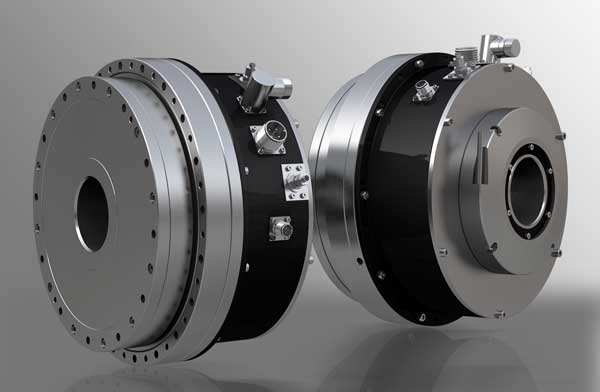 16.09.2015 | Nabtesco presents for the first time a servo motor in combination with the RV gear. In order to save space when used in the machine tool, this high-precision servo drive was developed, which can be used in the future as an alternative to the direct drive. In the past, worm gears were mainly used in milling or swivel heads, but direct drives are still state-of-the-art today.
16.09.2015 | Nabtesco presents for the first time a servo motor in combination with the RV gear. In order to save space when used in the machine tool, this high-precision servo drive was developed, which can be used in the future as an alternative to the direct drive. In the past, worm gears were mainly used in milling or swivel heads, but direct drives are still state-of-the-art today.
The developers are now combining a flat servomotor with the Precision gear Technology that offers much less installation space than a direct drive. Due to the interaction with the reduction gear, higher forces can be transmitted and a significantly smaller motor can be used. With the same performance data, the space saving is up to 50% when installed in the machine tool.
The combination of servo motor and cycloidal gears enables the highest torques with exact positioning accuracy. In addition to simple integration and low installation costs, the high-precision servo drive is maintenance-free and has a high power density. Customer-specific adjustments are also possible without any problems. A generous hollow shaft also allows cables, lines or lasers to be fed through.
Compact synchronous servomotors with high dynamics
 28.04.2015/XNUMX/XNUMX | The highly dynamic AC synchronous servomotors of the FR series from Hiwin deliver high torque across the entire speed range – directly from standstill up to the maximum speed of 4500 rpm-1, The brushless, permanent-magnet-excited motors in sizes from 50 to 1000 W achieve peak torques from 0,48 to 14,3 Nm, depending on the model.
28.04.2015/XNUMX/XNUMX | The highly dynamic AC synchronous servomotors of the FR series from Hiwin deliver high torque across the entire speed range – directly from standstill up to the maximum speed of 4500 rpm-1, The brushless, permanent-magnet-excited motors in sizes from 50 to 1000 W achieve peak torques from 0,48 to 14,3 Nm, depending on the model.
The series is expanded by versions with 2000 and 4000W expanded, which are expected to be available from the end of this year. Thanks to their minimal mass moments of inertia, the models in the FR series are also suitable for demanding dynamic drive tasks such as high-frequency reversing operation. Due to the special stator-rotor design, very low torque ripple and high power density are achieved with a compact motor design.
In cramped installation conditions, the optimized cable outlet facilitates the space-saving installation the engines. The drives are equipped as standard with an incremental encoder measuring system with a resolution of 13 bits. Equipment with a holding brake is available as an option.
Direct drives and servomotors with Industrial Ethernet
 31.10.2014/XNUMX/XNUMX | The new generation of servo controllers ESR Pollmeier are suitable for applications with direct drives and classic servo motors. Networked with Industrial Ethernet, the drives can be integrated into Industry 4.0 environments. Optimized algorithms for controlling servo motors ensure better control properties in the new generation of servo controllers.
31.10.2014/XNUMX/XNUMX | The new generation of servo controllers ESR Pollmeier are suitable for applications with direct drives and classic servo motors. Networked with Industrial Ethernet, the drives can be integrated into Industry 4.0 environments. Optimized algorithms for controlling servo motors ensure better control properties in the new generation of servo controllers.
These come with in applications direct drives effective, i.e. in linear motors or torque motors as well as in classic AC servo motors. Stainless steel motors, for example for the food industry, will also be on display at the trade fair for the first time.
The ones with integrated Safety Technology Equipped servo controllers can be controlled either via Profinet, Ethercat, Modbus/TCP, CAN open or analogue interface. Networking via Industrial Ethernet forms the basis for integration within the framework of Industry 4.0: the manufacturer offers software modules and services for this. The servo controllers are available in nine power levels up to 15 kW with rated currents from 0,8 A to 32 A (up to 64 A peak current). The connection is made directly to 230 V or 3 × 400/480 V (wide-range inputs).
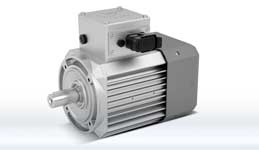 IE5 + synchronous motor for variant reduction and TCO reduction
IE5 + synchronous motor for variant reduction and TCO reduction
The new AC servo motors in stainless steel are suitable for applications with very high demands on hygiene and corrosion protection. The motors of the ME 74 series cover a torque range from 0,3 to 18 Nm (up to 80 Nm peak). Come if needed planetary gear or stainless steel bevel gears are used.
Thanks to the high degree of protection up to IP66K/IP69K they are suitable for environments in which aggressive cleaning agents and disinfectants as well as high-pressure cleaners are used. In accordance with the EHEDG guidelines, the housing and shaft are made of stainless steel. The smooth surfaces make cleaning easier, optionally supported by the single-cable version, in which position encoder signals and motor power are routed in the same cable.
Low-maintenance servo drives for automatic screw feeding
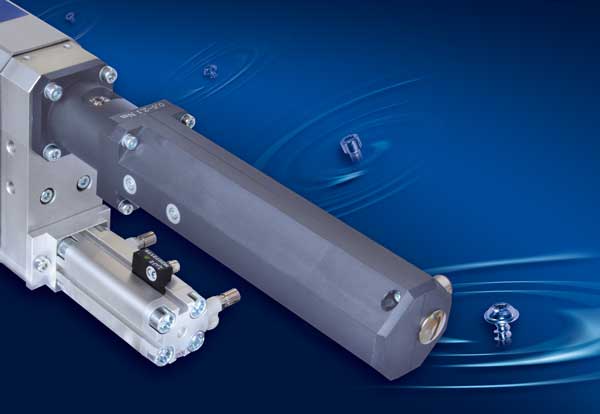 24.09.2014/XNUMX/XNUMX | Where screws are screwed in series assembly, semi- or fully automatic systems are increasingly being used for screw feeding. Servo drives have been standard here for some time Glandtechnology used. Pneumatic drives with a shut-off clutch, on the other hand, are no longer up-to-date. However, servo systems with or without a transducer are often expensive. WSM Automation closes the supply gap for many applications with its new electric drives.
24.09.2014/XNUMX/XNUMX | Where screws are screwed in series assembly, semi- or fully automatic systems are increasingly being used for screw feeding. Servo drives have been standard here for some time Glandtechnology used. Pneumatic drives with a shut-off clutch, on the other hand, are no longer up-to-date. However, servo systems with or without a transducer are often expensive. WSM Automation closes the supply gap for many applications with its new electric drives.
The new drive series includes brushless and thus low-maintenance electric drivesthat have an adjustable shut-off clutch They are started externally via a 24 V signal and send a signal to the higher-level controller that the clutch has been engaged or the torque has been reached. Various speed or torque combinations are available here. The bandwidths vary between 600 and 1500 min-1 and 0,05 to 5,5 Nm.
The drives work without much programming effort and without a separate nutrunner control. The flange dimensions are identical to those of high-quality servo drives and previously installed air motors. Should the quality requirements change or older air drives be replaced by new systems, extensions or conversions can be implemented with minimal effort.
Servo motors 2013 to 2011
- Modular servomotors with integrated PLC functionality
- High torque permanent magnet AC synchronous motor
- Servo drives for highly dynamic forming machines
Modular servomotors with integrated PLC functionality
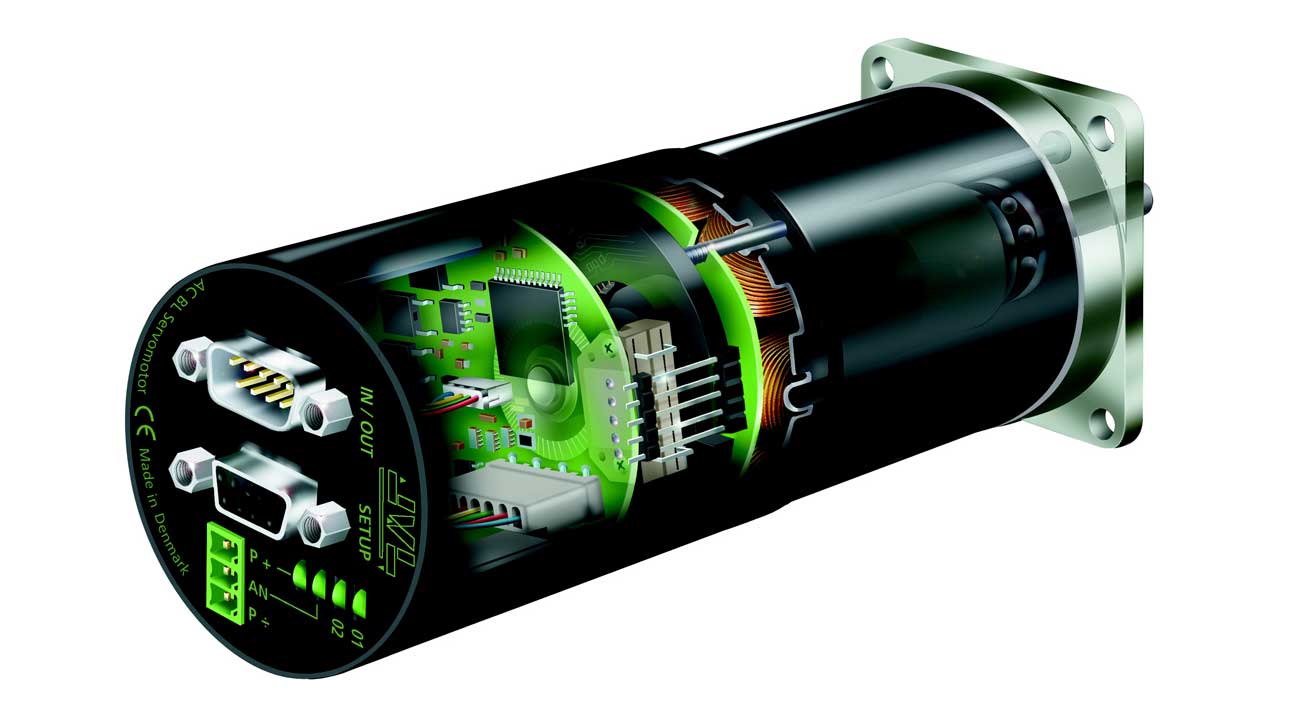
14.02.2013/XNUMX/XNUMX | Integrated servo technology is becoming increasingly popular in Europe and is prompting many designers to rethink. The systems are available today in a wide variety of designs, dimensions and performance levels in order to meet all requirements. JVL presents motors from 400 W with integrated PLC functionality at the Hanover Fair.
The Danish company JVL Industrie Elektronik A/S was founded in 1986. Initially conceived as a fixed idea alongside my studies, a company quickly developed from it. The basis for the early success was the use of the latest technologies, which the two company owners skillfully used in their products even back then. At the beginning, the development and marketing focused on extremely modern and compact Driver stages for stepper motors, with which the young company found a high level of acceptance in the market. Through the acquisition of a Danish company, the product portfolio was expanded to include AC and DC servo amplifiers. This step gave the founders Bo Valeur Jessen and Mads Vernon Jørgensen the idea of supplying the motor and amplifier as a single unit.
Servomotor with amplifier and drive unit in one
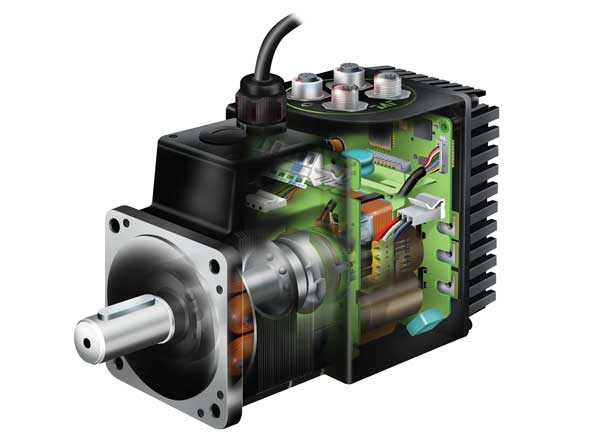 The integrated servo motor is a complete one AC servo motor with amplifier and control unit in one device. It offers a modular, exact fitting solution. Up to the market launch of the first integrated servo motor about 10 years ago, the integration of the electronics in a motor was only practiced with inverters, but not with motors which Servo performance could offer. For these compact servos, the engine, the Hall sensors, the encoder, the power amplifier and the controller have been redesigned to withstand shocks and avoid unnecessary temperature build-up, for example.
The integrated servo motor is a complete one AC servo motor with amplifier and control unit in one device. It offers a modular, exact fitting solution. Up to the market launch of the first integrated servo motor about 10 years ago, the integration of the electronics in a motor was only practiced with inverters, but not with motors which Servo performance could offer. For these compact servos, the engine, the Hall sensors, the encoder, the power amplifier and the controller have been redesigned to withstand shocks and avoid unnecessary temperature build-up, for example.
As a motor comes a brushless servo motor used, the rotor of which consists of high-performance magnets. The Hall sensor is located at the rear of the motor and provides information about the position of the rotor magnets during start-up. With the signals from the Hall sensors, the correct commutation of the motor is ensured by adjusting the voltage on the 3 motor phases in such a way that the magnetic alignment is optimized for maximum torque at minimum current. After the motor has started, only the encoder placed behind the Hall effect sensor is responsible for the position and speed feedback and motor operation is 100% digital.
The control circuit that regulates the torque, speed and position consists of a digital controller and driver stage. the data center is an extremely powerful high-performance microprocessor. The processor receives its specifications via a built-in expansion module and carries out the digital current, speed and positioning control accordingly. The signals from the optical or mechanical encoder are processed to determine the speed and position.
The integrated servo motor is equipped with different operating modes to work with the Basic configuration to cover as many applications as possible. The operating mode is set via a Parameterization software selected, which includes speed, torque control or positioning via ± 10 VDC as well as control via pulse/direction signal. The latter offers the simple option of upgrading a previous stepper motor application to servo performance. The zero position of the drive can be selected to suit the application, either using a reference point switch, a mechanical stop using the torque method, or setting the zero point using the software. In the case of a servo motor with a mechanical absolute value encoder, this is only necessary once.
Decentralization of system intelligence
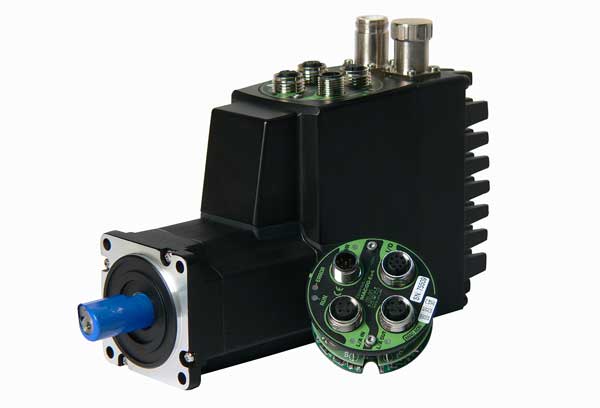 The advantages of an application solution with compact servomotors include: decentralization of system intelligence and the saving of expensive cables between motor and amplifier. This simplifies installation, saves space in the control cabinet, avoids wiring errors and reduces EMC problems.
The advantages of an application solution with compact servomotors include: decentralization of system intelligence and the saving of expensive cables between motor and amplifier. This simplifies installation, saves space in the control cabinet, avoids wiring errors and reduces EMC problems.
Another advantage is the adaptation of the drives to the needs of the application through the use of expansion modules. In addition to modules with NanoPLC are the conventional ones fieldbusse Profibus, CAN open, Devicenet and Modbus, but also more exotic networks such as Bluetooth, Zigbee and WLan are available. Of course, Industrial Ethernet modules such as Ethercat, Profinet, Powerlink and Ethernet/IP are also offered.
For this year Hannover Messe The company JVL presents another highlight. The default integration of the known PLC functionality in the motors from 400 W. This gives the user the opportunity to process motor-specific or application-specific program parts directly in the motor in real time, without detours via the PLC.
High torque permanent magnet AC synchronous motor
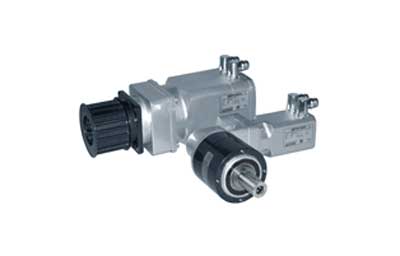 03.05.2012 | Bonfiglioli introduces a new range of BMD permanent magnet AC synchronous motors. These brushless servo motors are based on 6 torques corresponding to different flange sizes and motor powers, covering a range from 1,7 to 37 Nm. They are designed for three-phase operation with 230 V AC and 400 V AC power supply and free ventilation.
03.05.2012 | Bonfiglioli introduces a new range of BMD permanent magnet AC synchronous motors. These brushless servo motors are based on 6 torques corresponding to different flange sizes and motor powers, covering a range from 1,7 to 37 Nm. They are designed for three-phase operation with 230 V AC and 400 V AC power supply and free ventilation.
All models have a PTC (a KTY temperature sensor is offered as an option) and IP65 push-pull connector (IP67 optional) that meet all EMC requirements. The permanent magnet AC synchronous motors are salient pole rotors, which have the lowest level of inertia at high torque and offer very good performance.
The dimensions of the motors were drastically reduced, which brought significant advantages in terms of torque density, overall dimensions and dynamics. Thanks to their high quality and performance, those made of neodymium, iron, boron and rare earths magnets very high acceleration values and a high overload capacity without the risk of demagnetization.
The BMD servomotors are particularly suitable for Applications in the Plastic- and metalworking, packaging, food and beverage, winding and textile industries to name a few.
Servo drives for highly dynamic forming machines
 02.11.2011/XNUMX/XNUMX | The product family "Servox" from Desch was specially designed to meet the high demands on the kinematic movement profile of highly dynamic forming machines. In addition to the low mass moments of inertia in planetary gear an integrated, hydraulically released brake makes an additional safety/holding brake superfluous. The manufacturer supplied the main drive components for the high-tech test stand at the Fraunhofer Institute.
02.11.2011/XNUMX/XNUMX | The product family "Servox" from Desch was specially designed to meet the high demands on the kinematic movement profile of highly dynamic forming machines. In addition to the low mass moments of inertia in planetary gear an integrated, hydraulically released brake makes an additional safety/holding brake superfluous. The manufacturer supplied the main drive components for the high-tech test stand at the Fraunhofer Institute.
The Servox used in the test bench have a static braking torque of 6600 Nm each and are equipped with Siemens servomotors. Other makes of motor can easily be adapted. Due to these properties in connection with the high dynamics of the electrical components, Servox is suitable for use in machines with a pendulum stroke and modified ram speed. In addition to increased productivity in various work processes, the system also saves the user money thanks to its compact design.
The unit is equally suitable for new machines and for upgrading used machines by converting them to the Servox drive system. The product family includes servo drives with one and two-stage planetary gears, the DS version with several motors for the transmission of very high drive torques as well as special customer-specific solutions.
 Temperature Sensor | humidity sensor | vibration sensor
Temperature Sensor | humidity sensor | vibration sensor
At the Institute for Machine Tools and Forming Technology, a Servo press test stand developed and built. The concept of the test stand is based on a 2-point servo eccentric press and consists of several modular assemblies. The pressing force of 1000 kN with a stroke of 250 mm is applied via 2 drive modules of 500 KN each. The modules can also be operated separately from each other. The interchangeable modules are driven by Servox gears, each with an output torque of 25 kNm and a gear ratio of i=6.
In addition to developing the drives, Desch was also responsible for the hydraulics in the test bench project, which are responsible for lubricating the transmission and for controlling and cooling the safety brake is required as well as for the two overload safety units of the test stand.
Inverter
You can find the current inverter innovations here.
Archive frequency converter
You can find the latest frequency converter innovations here.
Frequency converter 2019 to 2017
- Frequency converter, servo and special drive in one device
- Chatbot support for frequency converters quickly eliminates errors
- Control cabinet converter with real-time Ethernet - Interview
- Application converters for synchronous and asynchronous motors
- Frequency converter for heavy and rough applications
- 360 degrees all-round carefree converter – video statement
Frequency converter, servo and special drive in one device
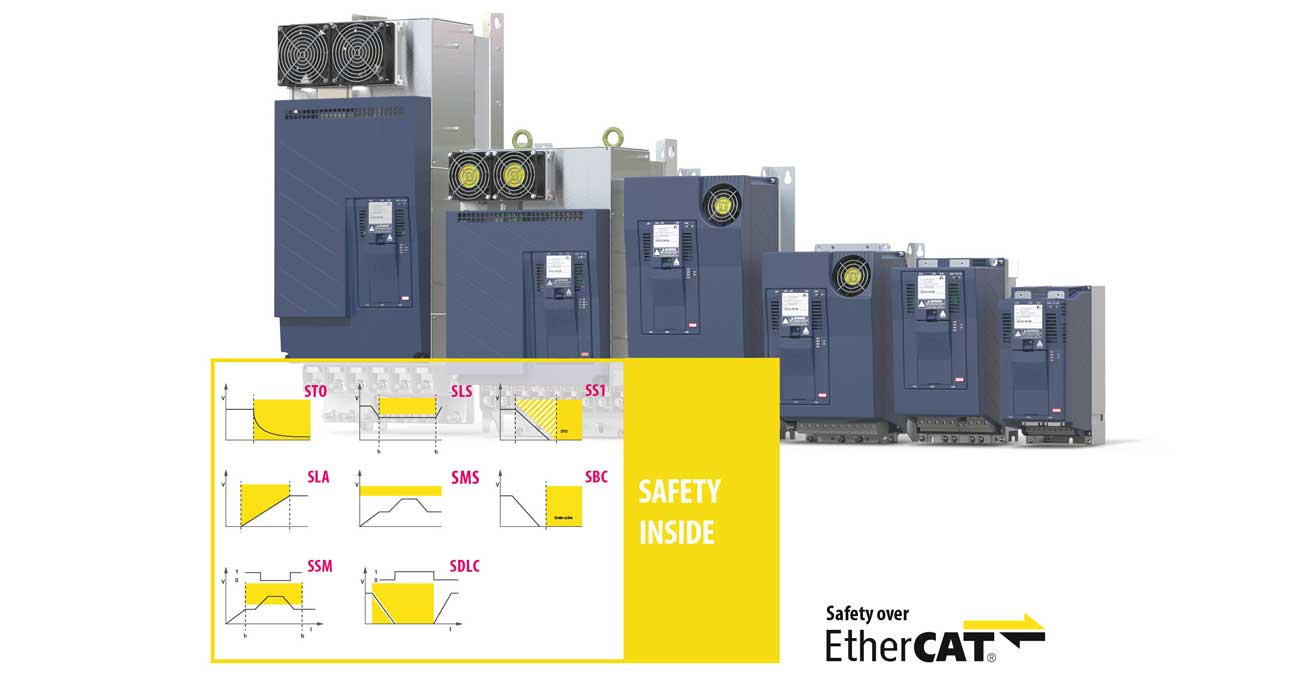
18.12.2019 | The universal drive controller "Combivert F6" from KEB Automation make frequency converter, Servo or special drive in one device. They simplify the selection in drive applications and thus optimize storage, logistics and costs. In addition to the previously four housing sizes for the frequency converters with rated outputs of up to 90 kW, there are now additional output levels of up to 450 kW for encoderless and encoder-based control of different motor technologies (ASM, SSM, IPM, SynRM).
High overload capacity, quick reaction to load changes or the universal connection to higher-level control systems - with these properties, the Combivert F6 dynamic tasks in machines and systems, cranes, elevators or lifting devices in the best possible way.
In addition to the particularly compact design, assemblies with a protective coating and high vibration resistance optimize operation in harsh environmental and operating conditions. With the concept All-in-One the devices offer a convenient control panel, protection of the supply network thanks to the choke and EMC filter, as well as functional safety about the safe torque shutdown. The selection and installation of the devices are as simple as their operation: The "Combivis 6" commissioning and diagnostics software makes application and handling easy with numerous wizards.
Chatbot support for frequency converters quickly eliminates errors
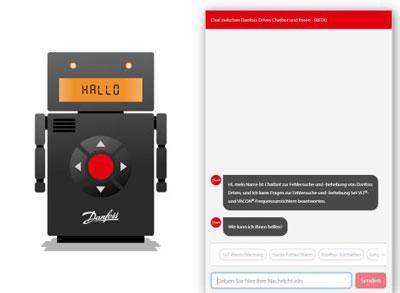 17.12.2019/XNUMX/XNUMX | Of the Danfoss Drives Troubleshooting Chatbot provides specific information on how to eliminate errors in the manufacturer's frequency converters. The user only needs the converter series and the error code shown on the display or system. This means that the digital helper can immediately provide information on the cause and tips on how to rectify it.
17.12.2019/XNUMX/XNUMX | Of the Danfoss Drives Troubleshooting Chatbot provides specific information on how to eliminate errors in the manufacturer's frequency converters. The user only needs the converter series and the error code shown on the display or system. This means that the digital helper can immediately provide information on the cause and tips on how to rectify it.
The exchange with the German-speaking chatbot saves Danfoss customers valuable time. They provide you with answers to questions about your drive around the clock. The exchange is made possible by an AI-based, learning computer software.
During chatbots in the B2C communication have been in use for a long time, the digital helper from Danfoss Drives is a unique service offering in the drive industry. Above all, he comes to the rescue for customers who need a lightning-fast response to their technical questions around the clock and answers questions in real time. The Danfoss chatbot already knows all codes for warnings, alarms and errors for the main Vacon and VLT frequency converters. The digital helper will also provide programming and installation support in the future.
Control cabinet converter with real-time Ethernet - Interview
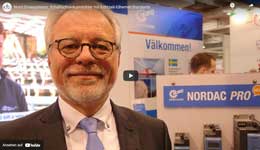
03.04.2019/XNUMX/XNUMX | On the Hannover Messe presented NORD a new development in frequency converters. Jörg Niermann told us in detail what it is and what it is suitable for. We asked the Head of Marketing at Getriebebau Nord questions about the highlights at the Hanover Fair.
Application converters for synchronous and asynchronous motors
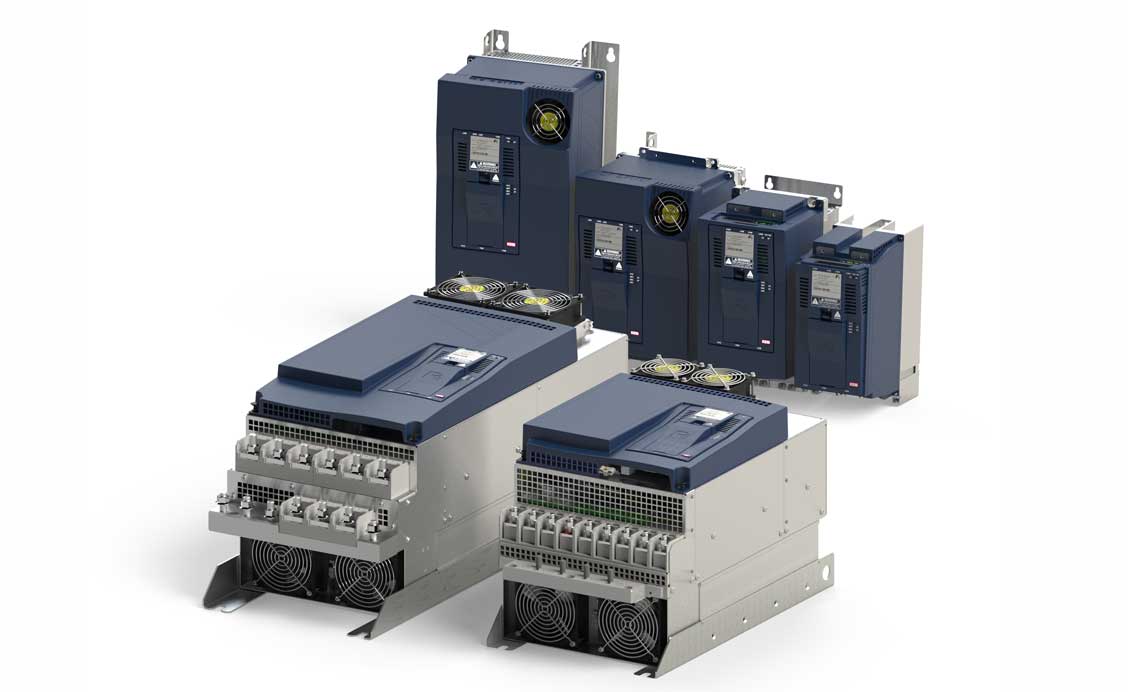
28.03.2019/XNUMX/XNUMX | The new drive controllers can be used universally for any motor technology and are functionally prepared for the drive tasks of speed, torque and position control Combivert F6 from KEB Automation. Two new sizes have now been added to the previous power range for motors up to 90 kW. The series now covers applications up to 315 kW.
In addition to universal motor operating modes for motors with or without sensors, the drive controllers enable a flexible connection to the higher control level via EtherCAT, Profinet, Powerlink, Ethernet/IP and CAN. In addition, they provide all proven speed and position feedback on the two encoder channels in one piece of hardware.
There is also an extensive range of integrated security features, the protective measures previously implemented externally in the machine or system are increasingly being incorporated into the drive and control packageElectronics integrate and thus optimize effort and system costs. The application and handling is rounded off by the commissioning and diagnostics software Combivis 6. In the current version, necessary adjustments to the application are supported by wizards, which make it possible to optimize the drive system to the requirements without a great deal of detailed knowledge.
High energy efficiency combined with excellent wave properties are the key to high-performance drive solutions in typical areas of application such as hoists, portals, cranes, palletizers, feed/removal devices or even extrusion and injection molding.
Frequency converter for heavy and rough applications
 07.02.2019 | Mitsubishi Electric completes its frequency converter portfolio and supplies devices for additional voltage and power ranges. The drive specialist offers Compact devices up to 630 kW, a liquid-cooled series for harsh operating conditions and special devices available at short notice for crane applications and wrap applications.
07.02.2019 | Mitsubishi Electric completes its frequency converter portfolio and supplies devices for additional voltage and power ranges. The drive specialist offers Compact devices up to 630 kW, a liquid-cooled series for harsh operating conditions and special devices available at short notice for crane applications and wrap applications.
360 degrees all-round carefree converter – video statement
 10.10.2017 | Mitsubishi Electric is presenting a new high-performance frequency converter at this year's Motek. Linda Lewalder, Senior Product Manager Inverter, Mitsubishi Electric Europe BV, Ratingen, presents the FR-A800-E using the application example of crane systems.
10.10.2017 | Mitsubishi Electric is presenting a new high-performance frequency converter at this year's Motek. Linda Lewalder, Senior Product Manager Inverter, Mitsubishi Electric Europe BV, Ratingen, presents the FR-A800-E using the application example of crane systems.
Frequency converter 2016 to 2012
- Modular frequency increase plant efficiency
- Regenerative frequency converters are making a big splash in Łódź
- Frequency converter with integrated PLC for monitoring the drive
- Medium-voltage converters with more than twice the rated power
- Energy-efficient frequency converter controls fan and pump
- Energy recovery by inverters in the vertical lift
- Decentralized drive technology with motor-mounted frequency converter
- Decentralized frequency converter with encoder connection
Modular frequency increase plant efficiency
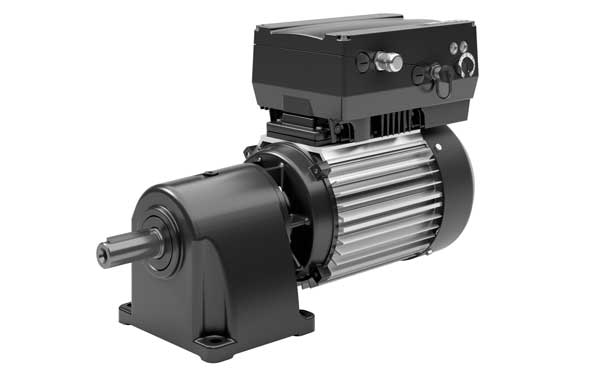 02.12.2016 | ABM Greiffenberger has expanded the product portfolio and now also offers the "Inveor" drive controller platform. The decentralized converter is particularly flexible thanks to its modular design and is suitable for many sectors and applications. The controller offers users a variety of options for increasing the efficiency of systems.
02.12.2016 | ABM Greiffenberger has expanded the product portfolio and now also offers the "Inveor" drive controller platform. The decentralized converter is particularly flexible thanks to its modular design and is suitable for many sectors and applications. The controller offers users a variety of options for increasing the efficiency of systems.
All proprietary asynchronous and synchronous motors are optimally matched to the converter. The combination of the high motor efficiencies with the use of efficient converters results in a particularly energy-efficient drive system with high savings potential. the Inside Alpha in the medium line there is a power range from 0,25 to 0,75 kW. For more complex applications, the Premium Line is available with outputs from 0,37 to 22 kW. Based on a wealth of experience from the development and production of customer-specific drive technology, a solution has been created that can be used universally thanks to its modular structure. The Inveor platform is designed in such a way that user-specific applications can be easily implemented.
The drive controller offers a intuitive operating and programming concept. The user receives relevant information about the operating status of the frequency converter at any time via a handheld terminal with a plain text display. With optional fieldbussystems such as CANopen, Ethercat or Profibus as well as an integrated PLC function according to EN 61131-3, it is very well suited for use in Industry 4.0 environments. Touchscreen terminals for control and visualization are available as accessories.
Regenerative frequency converters are making a big splash in Łódź
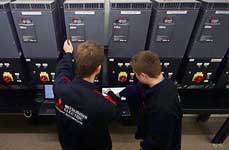
10.11.2016/XNUMX/XNUMX | With art we can transcend the boundaries of time and, for example, travel back to ancient Greece, to the origins of the theater. But have something art and automation together? Quite simply: a modern theater cannot function without them. Which role Mitsubishi Electric plays, shows this application in Łódź.
Frequency converter with integrated PLC for monitoring the drive
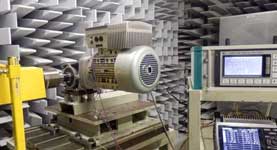 16.05.2016 | NORD uses frequency converters with integrated PLC for self-monitoring of the drive. They monitor the entire drive system with foresight, evaluate sensor data and use intelligent algorithms to assess the system status.
16.05.2016 | NORD uses frequency converters with integrated PLC for self-monitoring of the drive. They monitor the entire drive system with foresight, evaluate sensor data and use intelligent algorithms to assess the system status.
Medium-voltage converters with more than twice the rated power
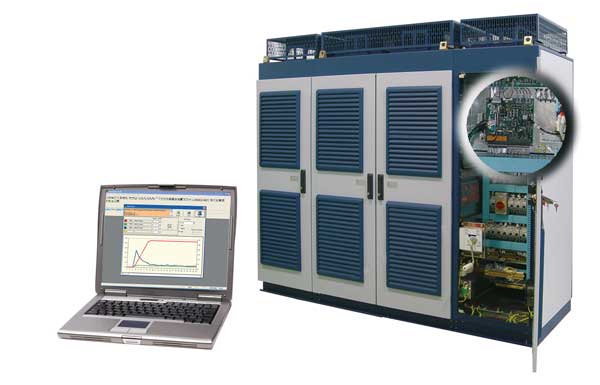 20.01.2015 | WEG has significantly increased the performance of the medium-voltage frequency converter MVW01. The rated power of the devices in the air-cooled version with voltages of 2300 or 4160 V has been increased from the previous 6500 to 16.000 kW. The MVW01 converters for three-phase asynchronous and synchronous motors are also available in a water-cooled version. The latter offers a nominal power that is 40% higher for the same size. The product range now covers voltages from 2,3 to 6,9 kV and power ratings from 400 to 16.000 kW.
20.01.2015 | WEG has significantly increased the performance of the medium-voltage frequency converter MVW01. The rated power of the devices in the air-cooled version with voltages of 2300 or 4160 V has been increased from the previous 6500 to 16.000 kW. The MVW01 converters for three-phase asynchronous and synchronous motors are also available in a water-cooled version. The latter offers a nominal power that is 40% higher for the same size. The product range now covers voltages from 2,3 to 6,9 kV and power ratings from 400 to 16.000 kW.
At full load, the powerful MVW01 Thanks to the special design, an effective efficiency of over 99%. It is primarily used to drive pumps, fans, mills or agitators in the oil and gas, cement and mining, steel and metal, sugar and chemical, pulp and paper, Plastic and rubber as well as water and waste water.
The MVW01 has the following topology (Voltage Source Inverter, VSI), consisting of three-phase rectifiers, a DC voltage circuit and an output-side multilevel inverter in NPC technology (NPC = Neutral Point Clamped) with 3/5 voltage level for an output voltage of 2300 up to 4160 V and with 5/9 voltage level for an output voltage of 6000 to 6900 V. The converter is equipped with High Voltage Bipolar Transistors with insulated gate electrode, the latest generation for voltages up to 6,5 kV and a DC link with a 12-pulse rectifier bridge.
Energy-efficient frequency converter controls fan and pump
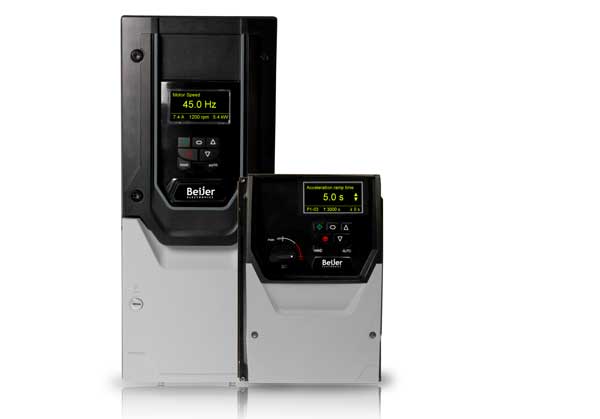 02.09.2014/3/XNUMX | The new HXNUMX series from Beijer Electronics was specially developed for the reliable control of HVAC applications. The H3 series inverters increase the efficiency of the drive system to more than 98%. As a result, proven energy savings enable reduced energy and operating costs and thus significant cost savings. At the same time, harmonics, which are often associated with electronic components and conventional variable-speed drives, are reduced to below 30% iTHD (Total Harmonic Distortion).
02.09.2014/3/XNUMX | The new HXNUMX series from Beijer Electronics was specially developed for the reliable control of HVAC applications. The H3 series inverters increase the efficiency of the drive system to more than 98%. As a result, proven energy savings enable reduced energy and operating costs and thus significant cost savings. At the same time, harmonics, which are often associated with electronic components and conventional variable-speed drives, are reduced to below 30% iTHD (Total Harmonic Distortion).
The HVAC Inverter H3 is available with a power range from 0,75 to 45 kilowatts and a 3-phase input with protection class IP55/IP66. They impress with their drive efficiency in connection with low distortion of the input voltage according to EN 61000-3-12. The H3 series reliably controls the latest generation of induction motors, permanent magnet AC motors, brushless DC motors and synchronous reluctance motors.
The frequency converters are easy to operate and designed to be extremely robust in a compact drive. the lower mains power supply allows the use of smaller cable diameters as well as smaller fuse sizes and transformers. Thanks to the low power factor, there are no additional costs for the energy supplier. The improved efficiency results in reduced operating costs, as this sample calculation shows: With a power consumption of 37 kilowatts, 10 hours of operation per day, 5 days per week and 50 weeks per year, the power consumption is 92 kWh. With a saving of 500%, this results in more than 1,1 kWh savings per year.
Energy recovery by inverters in the vertical lift
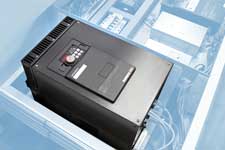 30.11.2012/XNUMX/XNUMX | Presented itself with a focus on energy-saving solutions Mitsubishi Electric an approximately 5 m high presentation showing how a Hänel Lean-Lift works. The compact FR-A741 inverter with integrated feedback function is in the ultra-modern lift system for intralogistics tasks.
30.11.2012/XNUMX/XNUMX | Presented itself with a focus on energy-saving solutions Mitsubishi Electric an approximately 5 m high presentation showing how a Hänel Lean-Lift works. The compact FR-A741 inverter with integrated feedback function is in the ultra-modern lift system for intralogistics tasks.
Decentralized drive technology with motor-mounted frequency converter
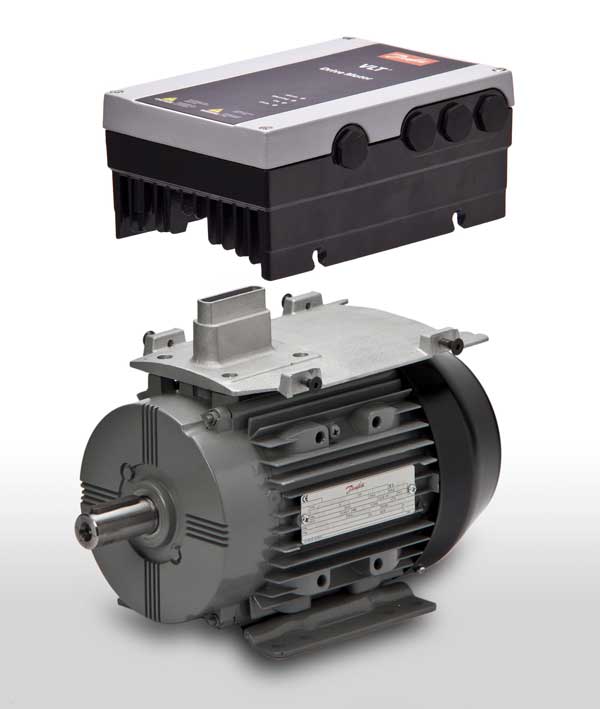 15.11.2012 | Danfoss shows the newly developed motor-mounted frequency converter "VLT Drive Motor FCM 106". The device can operate asynchronous and permanent magnet motors and can therefore be used universally, regardless of the technology. The drive is offered as a complete package, but the electronics can also be purchased on their own Drives equipped with a speed control.
15.11.2012 | Danfoss shows the newly developed motor-mounted frequency converter "VLT Drive Motor FCM 106". The device can operate asynchronous and permanent magnet motors and can therefore be used universally, regardless of the technology. The drive is offered as a complete package, but the electronics can also be purchased on their own Drives equipped with a speed control.
The VLT Drive Motor FCM 106 as a combination of motor and frequency converter offers a space-saving alternative for fan, pump and industrial drives. It covers the power range from 0,55 to 22 kilowatts and is designed as a complete package with an asynchronous or permanent magnet motor. However, the user can also order the frequency converter upper part FCP 106 and mount it on an existing or own motor. The connection between FCP106 and motor is considered up to a power of 7,5 kilowatts Connectors executed, so the device is very easy to assemble.
Thanks one self-cooling and an individually adaptable adapter plate, the device can be adapted to a wide variety of motors and is therefore very well suited for your own drive solutions. This makes it very easy to comply with the EU directive on motor efficiency – also as a retrofit solution.
The VLT Drive Motor further offers a high degree of protection, a robust housing, high-quality EMC filters (mains + motor) and user-friendly operation. A deliberately low number of variants reduces storage costs. The FCM 106 also withstands adverse environmental conditions with heavy dirt, moisture or dust, large temperature fluctuations or vibrations, etc. If required, the frequency converter part of the FCM 300 can be replaced by that of the FCM 106 using specially adapted adapter plates.
Decentralized frequency converter with encoder connection
 30.04.2012/XNUMX/XNUMX | Conventional decentralized servo solutions are complex and expensive, but have often been the only way to implement positioning applications in remote locations. Here offers NORD with the SK 200E series, an alternative based on a frequency converter.
30.04.2012/XNUMX/XNUMX | Conventional decentralized servo solutions are complex and expensive, but have often been the only way to implement positioning applications in remote locations. Here offers NORD with the SK 200E series, an alternative based on a frequency converter.

